mod 3 / ch. 20 quattrocento period of renaissance art
0.0(0)
Card Sorting
1/87
Earn XP
Description and Tags
Study Analytics
Name | Mastery | Learn | Test | Matching | Spaced |
|---|
No study sessions yet.
88 Terms
1
New cards
15th Century Italian Art
next you will learn about the beginnings of the Italian Renaissance. More specifically, we will study the developments in naturalism and perspective. You will be introduced to artists such as Donatello, Ghiberti, and Brunelleschi.
\
15th century Italian Art is the art of the 1400s also known in Italian as Quattrocento. The Renaissance is defined as the rebirth of antiquity. Some art historians think of this period more so as a reinterpretation of antiquity in which humanism impacts philosophical thought and the arts. As opposed to the Middle Ages, where artists worked in guilds, in the Renaissance we see the rise of the individual artist. The age is also marked by new leisure and the rise of wealth among families such as the Medici. The Medici were great patrons of the arts and serve to highlight the importance of the context of the work of art as reflecting the history, culture, and society in which it was made, and its purpose.
\
15th century Italian Art is the art of the 1400s also known in Italian as Quattrocento. The Renaissance is defined as the rebirth of antiquity. Some art historians think of this period more so as a reinterpretation of antiquity in which humanism impacts philosophical thought and the arts. As opposed to the Middle Ages, where artists worked in guilds, in the Renaissance we see the rise of the individual artist. The age is also marked by new leisure and the rise of wealth among families such as the Medici. The Medici were great patrons of the arts and serve to highlight the importance of the context of the work of art as reflecting the history, culture, and society in which it was made, and its purpose.
2
New cards
\
terms
terms
**atmospheric perspective** - Atmospheric, or aerial, perspective creates the illusion of distance by the greater diminution of color intensity, the shift in color toward an almost neutral blue, and the blurring of contours as the intended distance between eye and object increases.
**continuous narrative** - Narrative that presents different events in time within the same work of art.
**contrapposto** - The disposition of the human figure in which one part is turned in opposition to another part (usually hips and legs one way, shoulders and chest another), creating a counter positioning of the body about its central axis. Sometimes called "weight shift" because the weight of the body tends to be thrown to one foot, creating tension on one side and relaxation on the other.
**Humanism** - In the Renaissance, an emphasis on education and on expanding knowledge (especially of classical antiquity), the exploration of individual potential and a desire to excel, and a commitment to civic responsibility and moral duty.
**l****inear perspective** - A method of presenting an illusion of the three-dimensional world on a two-dimensional surface. In linear perspective, the most common type, all parallel lines or surface edges converge on one, two, or three vanishing points located with reference to the eye level of the viewer (the horizon line of the picture), and associated objects are rendered smaller the farther from the viewer they are intended to seem.
**niche** - An ornamental recess in a wall or the like, usually semicircular in plan and arched, as for a statue or other decorative object.
**predella** - The narrow ledge on which an *altarpiece* rests on an altar.
**quatrefoil** - A shape or plan in which the parts assume the form of a cloverleaf.
**Renaissance** - French, "rebirth." The term used to describe the history, culture, and art of 14th through the 16th century Western Europe during which artists consciously revived the classical style.
**schiacciato** - squashed relief, very low relief practiced by ^^Donatello.^^
**continuous narrative** - Narrative that presents different events in time within the same work of art.
**contrapposto** - The disposition of the human figure in which one part is turned in opposition to another part (usually hips and legs one way, shoulders and chest another), creating a counter positioning of the body about its central axis. Sometimes called "weight shift" because the weight of the body tends to be thrown to one foot, creating tension on one side and relaxation on the other.
**Humanism** - In the Renaissance, an emphasis on education and on expanding knowledge (especially of classical antiquity), the exploration of individual potential and a desire to excel, and a commitment to civic responsibility and moral duty.
**l****inear perspective** - A method of presenting an illusion of the three-dimensional world on a two-dimensional surface. In linear perspective, the most common type, all parallel lines or surface edges converge on one, two, or three vanishing points located with reference to the eye level of the viewer (the horizon line of the picture), and associated objects are rendered smaller the farther from the viewer they are intended to seem.
**niche** - An ornamental recess in a wall or the like, usually semicircular in plan and arched, as for a statue or other decorative object.
**predella** - The narrow ledge on which an *altarpiece* rests on an altar.
**quatrefoil** - A shape or plan in which the parts assume the form of a cloverleaf.
**Renaissance** - French, "rebirth." The term used to describe the history, culture, and art of 14th through the 16th century Western Europe during which artists consciously revived the classical style.
**schiacciato** - squashed relief, very low relief practiced by ^^Donatello.^^
3
New cards
Important Historical Events and People:
%%**(FIFTEENTH-CENTURY ITALY)**%%
%%**(FIFTEENTH-CENTURY ITALY)**%%
* ^^**Giangaleazzo Viscont**^^i of Milan in 1401 surrounded Florence with his troops and died mysteriously in 1402. This relates to the commission of Ghiberti's first set of doors.
* Arte de la Calimala (Wool merchant's guild) has panel competition for East doors later moved to North of baptistery.
* King Ladislaus of Naples threatened to overrun Florence around 1409 and dies in 1414. In 1406 there is a dictum set in place for the completion of the sculptures of Or San Michele.
* Patrons Pietro & Felice Brancacci payed for the Brancacci Chapel. The subject is found in the Gospel of Matthew and relates to the tax collection in Caperneum. There was also a local tax, catasto, or perhaps a church taxation during the Renaissance that can relate to the rare art historical subject.
* Other Patrons: ^^**Palla Strozzi, The Medici, Lenzi**^^
* Arte de la Calimala (Wool merchant's guild) has panel competition for East doors later moved to North of baptistery.
* King Ladislaus of Naples threatened to overrun Florence around 1409 and dies in 1414. In 1406 there is a dictum set in place for the completion of the sculptures of Or San Michele.
* Patrons Pietro & Felice Brancacci payed for the Brancacci Chapel. The subject is found in the Gospel of Matthew and relates to the tax collection in Caperneum. There was also a local tax, catasto, or perhaps a church taxation during the Renaissance that can relate to the rare art historical subject.
* Other Patrons: ^^**Palla Strozzi, The Medici, Lenzi**^^
4
New cards
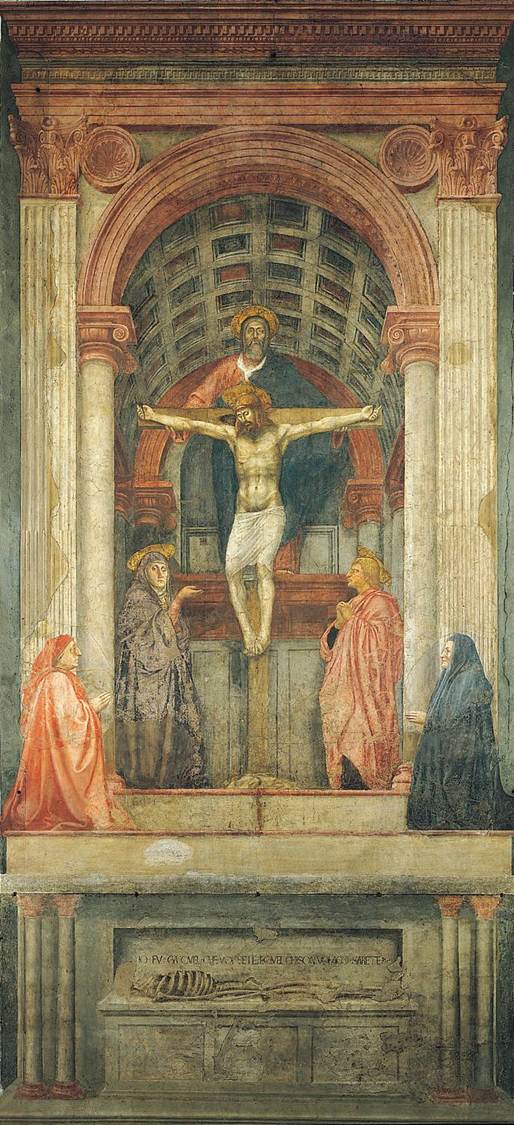
Masaccio and Brunelleschi
%%**(FIFTEENTH-CENTURY ITALY)**%%
%%**(FIFTEENTH-CENTURY ITALY)**%%
**Linear Perspective:**
Masaccio and Brunelleschi are seen as innovators in their respective fields of a painting and architecture. Their works reached new heights with the fine tuning and exploration of linear perspective. Filippo Brunelleschi, who lost the competition for the baptistery doors against Lorenzo Ghiberti, is credited with the invention of linear perspective.
Masaccio's innovations in fresco painting include linear and atmospheric perspective as well as improvements in the lifelike quality of figures and their modeling with the use of shadows. This can be seen in the Brancacci Chapel and Holy Trinity frescoes. Brunelleschi was able to span the 140 foot opening of the Florence Cathedral by constructing a double shelled dome with 8 exterior ribs.
Masaccio and Brunelleschi are seen as innovators in their respective fields of a painting and architecture. Their works reached new heights with the fine tuning and exploration of linear perspective. Filippo Brunelleschi, who lost the competition for the baptistery doors against Lorenzo Ghiberti, is credited with the invention of linear perspective.
Masaccio's innovations in fresco painting include linear and atmospheric perspective as well as improvements in the lifelike quality of figures and their modeling with the use of shadows. This can be seen in the Brancacci Chapel and Holy Trinity frescoes. Brunelleschi was able to span the 140 foot opening of the Florence Cathedral by constructing a double shelled dome with 8 exterior ribs.
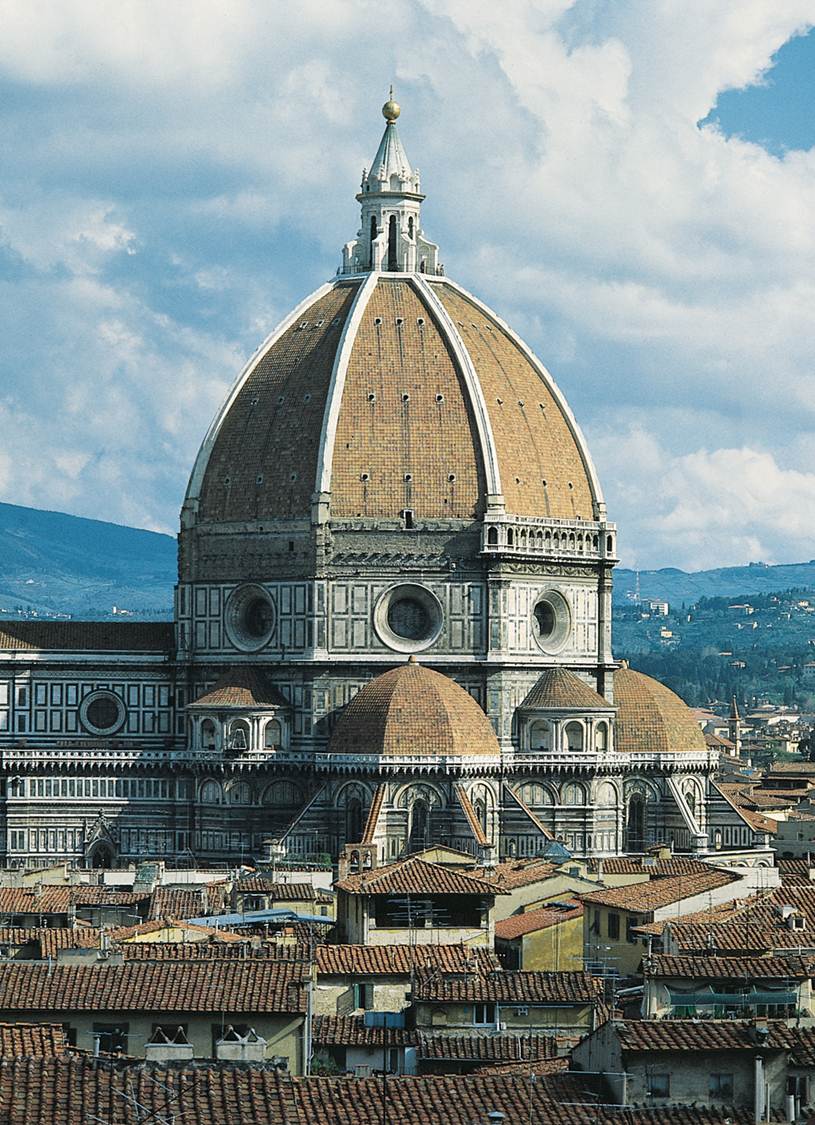
5
New cards

The Gates of Paradise
**The Competition**:
A competition was held by the city's guild of wool merchants to find an artist for the east portal of the Baptistry of San Giovanni for the Cathedral of Santa Maria del Fiore in Florence. The event highlights the importance of the individual artist, the rise of patronage as civic responsibility and promotional tool, and advancements in perspective all the while commemorating the spirit of competition in the Renaissance.
**The Subject:**
The subject of the competition panel was the Sacrifice of Isaac, an Old Testament subject from the Book of Genesis in which Abraham is ordered by God to sacrifice his son Isaac. An angel intervenes to stop him just as he is about plunge the knife into Isaac's throat. This theme of self- sacrifice has been connected to Giangaleazzo Visconti's attempted invasion of Florence in which city officials called upon the people to defend themselves from Milanese forces.
**The Winner**:
The competition panels that you will be comparing and contrasting show the predetermined subject of the sacrifice of Isaac in a quatrefoil form. The two panels from the finalists, Filippo Brunelleschi and Lorenzo Ghiberti, survive out of a total seven semifinalists that were considered. Ghiberti won the competition and his completed doors where moved to the north portal of the baptistery. His second set of doors are known as the "Gates of Paradise" because among many legends they face an area known as Paradise between the baptistery and the cathedral.
**The Gates:**
In the "Gates of Paradise" the quatrefoil form is abandoned in favor of the square that allows for the better use of perspective. The door has ten panels with subjects from the Old Testament. The panels are read from left to right, top to bottom, and demonstrate linear perspective with in each panel and overall as seen from a standing position in front of the doors. The doors also include a portrait of Ghiberti who was proud of his accomplishment.
A competition was held by the city's guild of wool merchants to find an artist for the east portal of the Baptistry of San Giovanni for the Cathedral of Santa Maria del Fiore in Florence. The event highlights the importance of the individual artist, the rise of patronage as civic responsibility and promotional tool, and advancements in perspective all the while commemorating the spirit of competition in the Renaissance.
**The Subject:**
The subject of the competition panel was the Sacrifice of Isaac, an Old Testament subject from the Book of Genesis in which Abraham is ordered by God to sacrifice his son Isaac. An angel intervenes to stop him just as he is about plunge the knife into Isaac's throat. This theme of self- sacrifice has been connected to Giangaleazzo Visconti's attempted invasion of Florence in which city officials called upon the people to defend themselves from Milanese forces.
**The Winner**:
The competition panels that you will be comparing and contrasting show the predetermined subject of the sacrifice of Isaac in a quatrefoil form. The two panels from the finalists, Filippo Brunelleschi and Lorenzo Ghiberti, survive out of a total seven semifinalists that were considered. Ghiberti won the competition and his completed doors where moved to the north portal of the baptistery. His second set of doors are known as the "Gates of Paradise" because among many legends they face an area known as Paradise between the baptistery and the cathedral.
**The Gates:**
In the "Gates of Paradise" the quatrefoil form is abandoned in favor of the square that allows for the better use of perspective. The door has ten panels with subjects from the Old Testament. The panels are read from left to right, top to bottom, and demonstrate linear perspective with in each panel and overall as seen from a standing position in front of the doors. The doors also include a portrait of Ghiberti who was proud of his accomplishment.
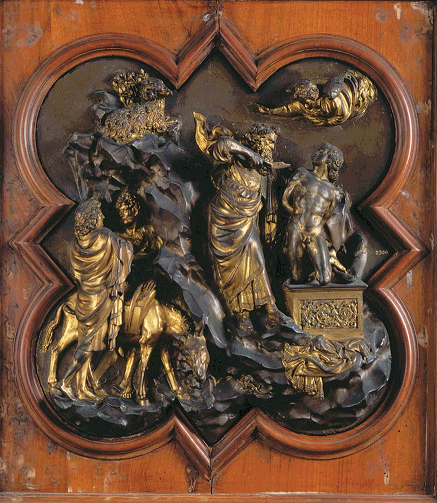
6
New cards
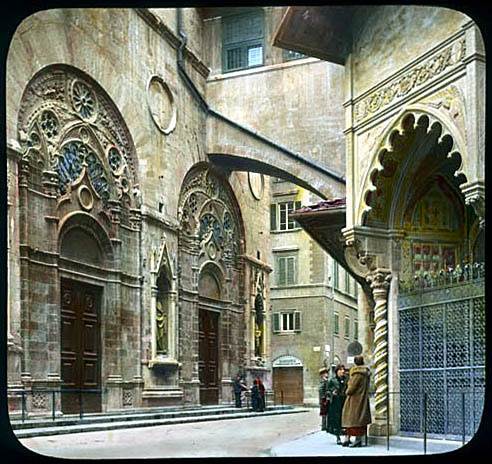
Or San Michele
**Patronage:**
* __This building illustrates clearly the connection between patronage and the work of art.__
* It also serves as a good visual summary of the major sculptors working during the **quattrocento.**
* %%**Or San Michele**%% was __**multi-functional building**____, it housed a miracle working image of the Madonna created by Orcanga, it was a granary, and meeting place for the guilds. As a meeting place for the guilds it also allowed for the exterior display of sculptures in niches that functioned much like a modern-day billboard.__
* These images advertised the guilds, their patron saints, and the products they produced.
* __This building illustrates clearly the connection between patronage and the work of art.__
* It also serves as a good visual summary of the major sculptors working during the **quattrocento.**
* %%**Or San Michele**%% was __**multi-functional building**____, it housed a miracle working image of the Madonna created by Orcanga, it was a granary, and meeting place for the guilds. As a meeting place for the guilds it also allowed for the exterior display of sculptures in niches that functioned much like a modern-day billboard.__
* These images advertised the guilds, their patron saints, and the products they produced.
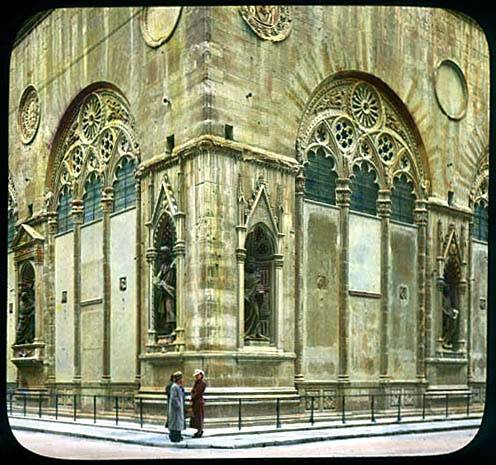
7
New cards
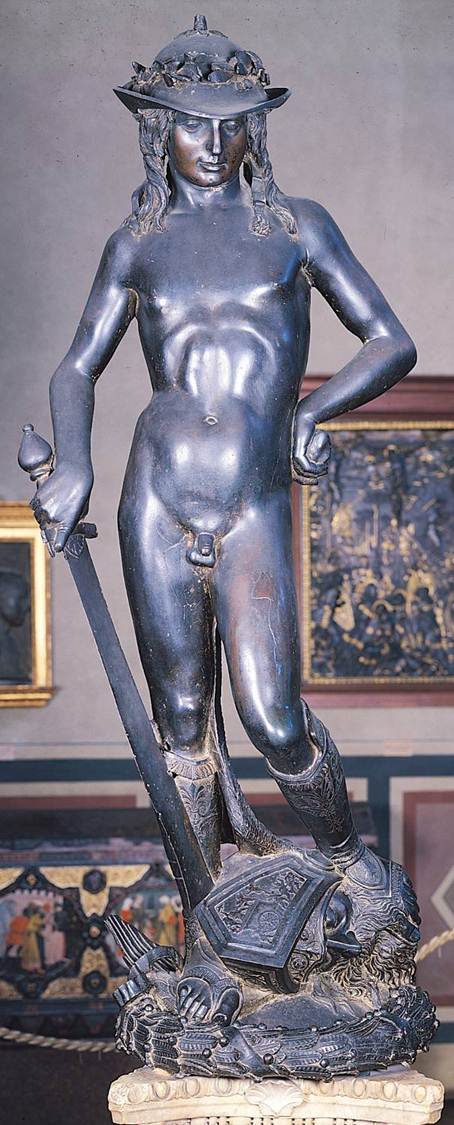
Donatello's David
Case Study:
This work is the first full sized nude figure since antiquity. The subject of David is important because the Old Testament hero that defeated Goliath was seen as a symbol of the Florentine Republic. The work does not have a secure patron nor date but is believed to have been made for the wedding of Piero de' Medici. Its' complicated iconography has been long debated by art historians and is referred to as homoerotic. The introspective figure is shown in a contrapposto stance wearing a petasus (shepherd's hat), and greaves while carrying a sword and a rock.
This work is the first full sized nude figure since antiquity. The subject of David is important because the Old Testament hero that defeated Goliath was seen as a symbol of the Florentine Republic. The work does not have a secure patron nor date but is believed to have been made for the wedding of Piero de' Medici. Its' complicated iconography has been long debated by art historians and is referred to as homoerotic. The introspective figure is shown in a contrapposto stance wearing a petasus (shepherd's hat), and greaves while carrying a sword and a rock.
8
New cards
Doumo in florence (1420-36)
built by brunelleschi who is said to have invented perspective in the renaissance
9
New cards
Ghiberti
won the competition for the east baptistry doors in 1401-2
10
New cards
Nanni di Banco (c. 1385–1421)
In about 1409, Nanni di Banco (c. 1385–1421), son of a sculptor in the Florence Cathedral workshop, was commissioned by the stonecarver and woodworkers’ guild (to which he himself belonged) to produce THE FOUR CROWNED MARTYRS (FIG. 20–12)
11
New cards
lenzi family
commissioned masaccio to paint the holy trinity fresco in 1428
12
New cards
Who cast the bronze "David" dated to 1420-50s patronized by the Medici?
Donatello
13
New cards
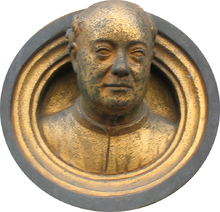
Lorenzo Ghiberti
%%**(FIFTEENTH-CENTURY ITALY)**%%
==**(EARLY RENNAISSANCE IN FLORENCE)**==
%%**(FIFTEENTH-CENTURY ITALY)**%%
==**(EARLY RENNAISSANCE IN FLORENCE)**==
* **Born**: Lorenzo di Bartolo; 1378 \n Florence, Republic of Florence
* **Died:** 1 December 1455 (aged 73–74) \n Florence, Republic of Florence
* **Nationality:** Italian
* **Known for**: __Sculpture__
* **Notable work:** Gates of Paradise, Florence Baptistery
* **Movement:** Early Renaissance
* **Died:** 1 December 1455 (aged 73–74) \n Florence, Republic of Florence
* **Nationality:** Italian
* **Known for**: __Sculpture__
* **Notable work:** Gates of Paradise, Florence Baptistery
* **Movement:** Early Renaissance
14
New cards
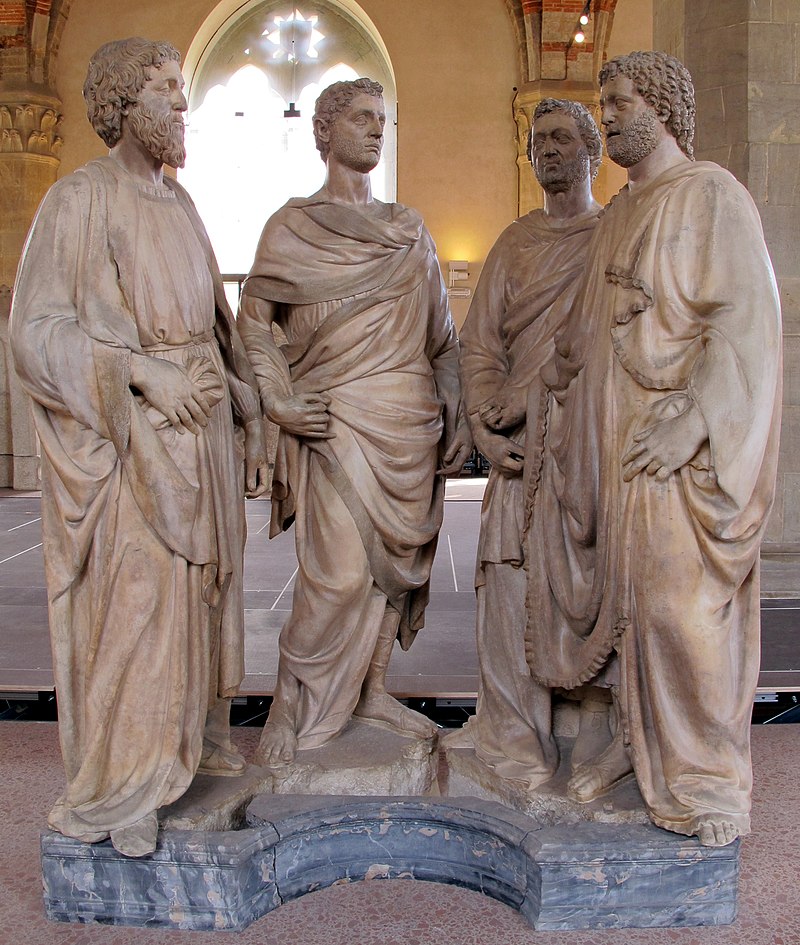
Four Crowned Martyrs (Nanni di Banco)
%%**(FIFTEENTH-CENTURY ITALY)**%%
==**(EARLY RENNAISSANCE IN FLORENCE)**==
%%**(FIFTEENTH-CENTURY ITALY)**%%
==**(EARLY RENNAISSANCE IN FLORENCE)**==
* **Artist:** Nanni di Banco
Four Crowned Martyrs is a sculptural group by Nanni di Banco. It forms part of a cycle of fourteen sculptures commissioned by the guilds of Florence for external niches of Orsanmichele, each sculpture showing that guild's patron saint.
\
Four Crowned Martyrs is a sculptural group by Nanni di Banco. It forms part of a cycle of fourteen sculptures commissioned by the guilds of Florence for external niches of Orsanmichele, each sculpture showing that guild's patron saint.
\
15
New cards
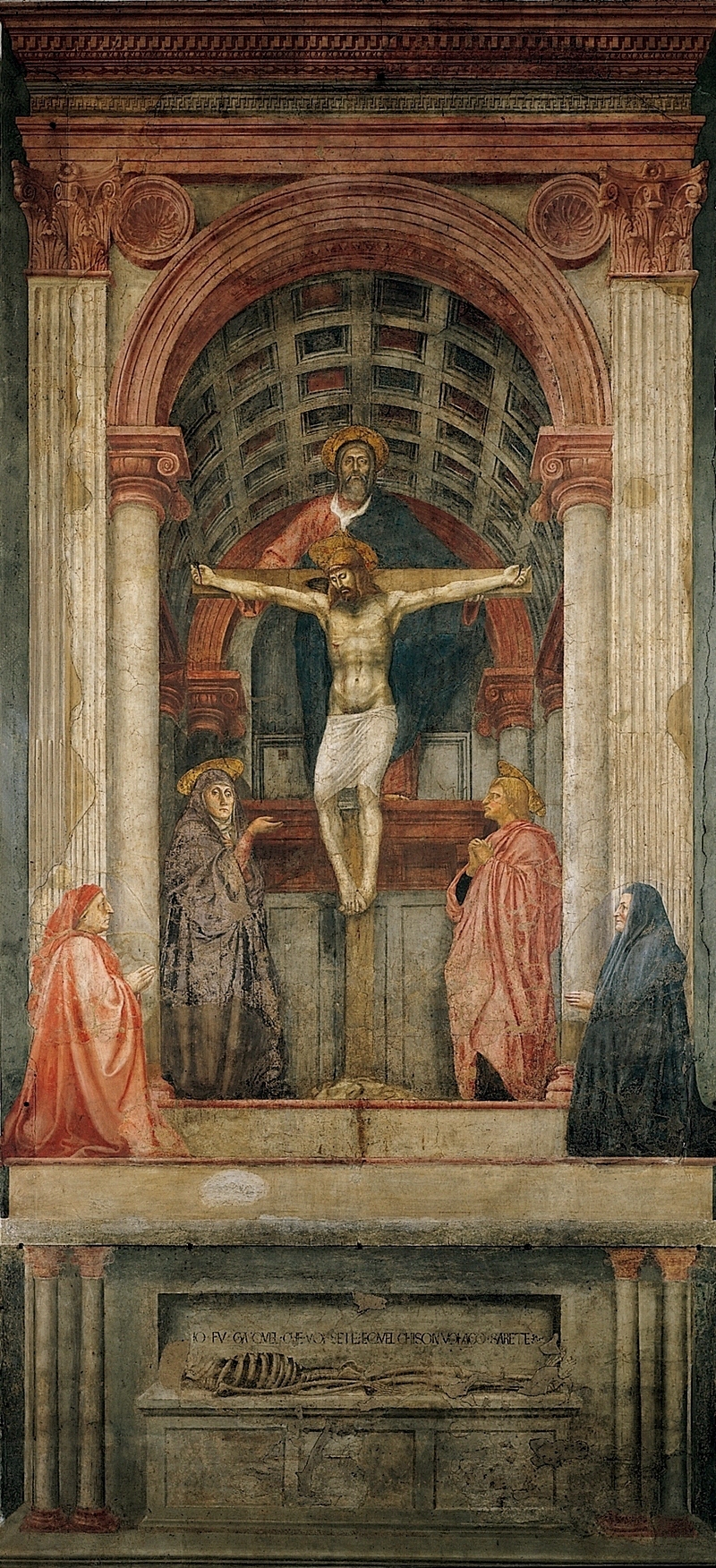
Holy Trinity (Masaccio)
%%**(FIFTEENTH-CENTURY ITALY)**%%
==**(EARLY RENNAISSANCE IN FLORENCE)**==
%%**(FIFTEENTH-CENTURY ITALY)**%%
==**(EARLY RENNAISSANCE IN FLORENCE)**==
* **Artist:** Masaccio
* **Year:** c.1426-1428
* **Type:** fresco
* **Dimensions**: 667 cm × 317 cm (263 in × 125 in)
* **Location:** Santa Maria Novella, Florence
* **Year:** c.1426-1428
* **Type:** fresco
* **Dimensions**: 667 cm × 317 cm (263 in × 125 in)
* **Location:** Santa Maria Novella, Florence
16
New cards

Florence Cathedral
%%**(FIFTEENTH-CENTURY ITALY)**%%
==**(EARLY RENNAISSANCE IN FLORENCE)**==
%%**(FIFTEENTH-CENTURY ITALY)**%%
==**(EARLY RENNAISSANCE IN FLORENCE)**==
* **Architect(s)**: Arnolfo di Cambio, Filippo Brunelleschi, Emilio De Fabris
* **Architectural type:** Church
* **Style**: Gothic, Romanesque, \n Renaissance
* **Groundbreaking:** 9 September 1296
* **Completed:** 1436
* **Architectural type:** Church
* **Style**: Gothic, Romanesque, \n Renaissance
* **Groundbreaking:** 9 September 1296
* **Completed:** 1436
17
New cards
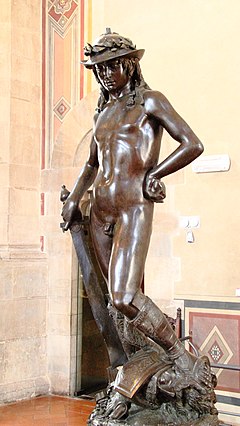
*David* (Donatello)
%%**(FIFTEENTH-CENTURY ITALY)**%%
==**(EARLY RENNAISSANCE IN FLORENCE)**==
%%**(FIFTEENTH-CENTURY ITALY)**%%
==**(EARLY RENNAISSANCE IN FLORENCE)**==
* **Artist:** Donatello
* **Period:** Early North Renaissance
\
David is the title of two statues of the biblical hero David by the Italian Early Renaissance sculptor Donatello. They consist of an early work in marble of a clothed figure, and a far more famous bronze figure that is nude except for helmet and boots, and dates to the 1440s or later.
* **Period:** Early North Renaissance
\
David is the title of two statues of the biblical hero David by the Italian Early Renaissance sculptor Donatello. They consist of an early work in marble of a clothed figure, and a far more famous bronze figure that is nude except for helmet and boots, and dates to the 1440s or later.
18
New cards
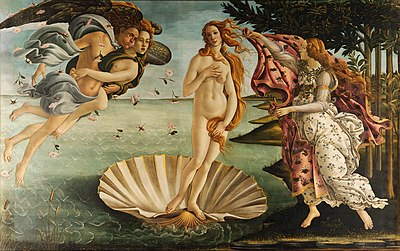
*The Birth of Venus*
%%**(FIFTEENTH-CENTURY ITALY)**%%
==**(FLORENTINE ART IN 2ND HALF OF 15TH CENTURY)**==
%%**(FIFTEENTH-CENTURY ITALY)**%%
==**(FLORENTINE ART IN 2ND HALF OF 15TH CENTURY)**==
* **Artist:** Sandro Botticelli
* **Dimensions:** 5′ 8″ x 9′ 2″
* **Location:** Uffizi Gallery
* **Created:** 1485–1486
* **Genre:** History painting
* **Subject:** Venus
* **Periods:** Renaissance, Italian Renaissance, Florentine painting, Early renaissance
\
The Birth of Venus is a painting by the Italian artist Sandro Botticelli, probably executed in the mid 1480s. It depicts the goddess Venus arriving at the shore after her birth, when she had emerged from the sea fully-grown. The painting is in the Uffizi Gallery in Florence, Italy.
* **Dimensions:** 5′ 8″ x 9′ 2″
* **Location:** Uffizi Gallery
* **Created:** 1485–1486
* **Genre:** History painting
* **Subject:** Venus
* **Periods:** Renaissance, Italian Renaissance, Florentine painting, Early renaissance
\
The Birth of Venus is a painting by the Italian artist Sandro Botticelli, probably executed in the mid 1480s. It depicts the goddess Venus arriving at the shore after her birth, when she had emerged from the sea fully-grown. The painting is in the Uffizi Gallery in Florence, Italy.
19
New cards
renaissance art in the fifteenth-century italy
This ferocious but bloodless battle seems to take place in a dream, but it depicts a historical event (FIG. 20–1). Under an elegantly fluttering banner, the Florentine general Niccolò da Tolentino leads his men against the Sienese at the Battle of San Romano, which took place on June 1, 1432. The battle rages across a shallow stage defined by the debris of warfare arranged in a neat pattern on a pink ground and backed by blooming hedges. In the center foreground, Niccolò holds up a baton of command, the sign of his authority. His bold gesture—together with his white horse and crimson-and-gold damask hat—ensures that he dominates the scene. His knights charge into the fray, and when they fall, like the soldier at the lower left, they join the many broken lances on the ground—all in conformity with the new mathematical depiction of receding space called linear perspective, posed to align with implied lines that converge at a single point on the horizon. An eccentric Florentine painter nicknamed Paolo Uccello (“Paul Bird”) created the panel painting (SEE FIG. 20–24) from which the detail in FIGURE 20–1 is taken. It is one of three related panels—now separated, hanging in major museums in Florence, London, and Paris—commissioned by Lionardo Bartolini Salimbeni (1404–1479), who led the Florentine governing Council of Ten during the war against Lucca and Siena. Uccello’s remarkable accuracy when depicting armor from the 1430s, heraldic banners, and even fashionable fabrics and crests surely would have appealed to Lionardo’s civic pride. The hedges of oranges, roses, and pomegranates—all ancient fertility symbols—suggest that Lionardo might have commissioned the paintings at the time of his wedding in 1438. Lionardo and his wife, Maddalena, had six sons, two of whom inherited the paintings. According to a later complaint brought by Damiano, one of the heirs, Lorenzo de’ Medici, the powerful de facto ruler of Florence, “forcibly removed” the paintings from Damiano’s house. They were never returned, and Uccello’s masterpieces are recorded in a 1492 inventory as hanging in the Medici palace. Perhaps Lorenzo, who was called “the Magnificent,” saw Uccello’s heroic pageant as a trophy more worthy of a Medici merchant prince. Princely patronage was certainly a major factor in the genesis of the Italian Renaissance as it developed in Florence during the early years of the fifteenth century
20
New cards
Humanism and the Italian Renaissance
__***What are the cultural and historical backgrounds of Italian Renaissance art and architecture?***__
By the end of the Middle Ages, the most important Italian cultural centers lay north of Rome in the cities of Florence, Milan, and Venice, and in the smaller court cities of Mantua, Ferrara, and Urbino. Political power and artistic patronage were both dominated by wealthy families: the Medici in Florence, the Montefeltro in Urbino, the Gonzaga in Mantua, the Visconti and Sforza in Milan, and the Este in Ferrara (MAP 20–1). Cities grew in wealth and independence as people migrated from the countryside in unprecedented numbers. Like in northern Europe, commerce became increasingly important. Money conferred status, and a shrewd business or political leader could become very powerful. The period saw the rise of mercenary armies led by entrepreneurial (and sometimes brilliant) military commanders called condottieri, who owed allegiance only to those who paid them well; their employer might be a city-state, a lord, or even the pope. Some condottieri, like Niccolò da Tolentino (SEE FIG. 20–1), became rich and famous. Others, like Federico da Montefeltro (SEE FIG. 20–39), were lords or dukes themselves, with territories of their own in need of protection. Patronage of the arts was an important public activity with political overtones. As one Florentine merchant, Giovanni Rucellai, succinctly noted, he supported the arts “because they serve the glory of God, the honour of the city, and the commemoration of myself” (cited in Baxandall, p. 2). The term Renaissance (French for “rebirth”) was only applied to this period by later historians. However, its origins lie in the thought of Petrarch and other fourteenth-century Italian writers, who emphasized the power and potential of human beings for great individual accomplishment. These Italian humanists also looked back at the thousand years extending from the disintegration of the Western Roman Empire to their own day and determined that the achievements of the Classical world were followed by what they perceived as a period of decline—a “middle” or “dark” age. They proudly saw their own era as a third age characterized by a revival or rebirth (“renaissance”), when humanity began to emerge from what they erroneously saw as intellectual and cultural stagnation to appreciate once more the achievement of the ancients and the value of rational, scientific investigation. They looked to the accomplishments of the Classical past for inspiration and instruction, and in Italy this centered on the heritage of ancient Rome. They sought the physical and literary records of the ancient world—assembling libraries, collecting sculpture and fragments of architecture, and beginning archaeological investigations. Their aim was to live a rich, noble, and productive life—usually within the framework of Christianity, but always adhering to a school of philosophy as a moral basis. Artists, like the humanists, turned to Classical antiquity for inspiration, emulating ancient Roman sculpture and architecture even as they continued to fulfill commissions for predominantly Christian subjects and buildings. But a number of home furnishings from the secular world, such as birth trays and marriage chests, have survived, richly painted with allegorical and mythological themes. Patrons began to collect art for their personal enjoyment. Like Flemish artists, Italian painters and sculptors increasingly focused their attention on rendering the illusion of physical reality. They did so in a more analytical way than the northerners. Rather than seeking to describe the visual appearance of nature through luminosity and detailed textural differentiation, Italian artists aimed at achieving lifelike but idealized weighty figures set in a space organized through strict adherence to linear perspective, a mathematical system that gave the illusion of a measured and continuously receding space (see “Renaissance Perspective” on page 623).
By the end of the Middle Ages, the most important Italian cultural centers lay north of Rome in the cities of Florence, Milan, and Venice, and in the smaller court cities of Mantua, Ferrara, and Urbino. Political power and artistic patronage were both dominated by wealthy families: the Medici in Florence, the Montefeltro in Urbino, the Gonzaga in Mantua, the Visconti and Sforza in Milan, and the Este in Ferrara (MAP 20–1). Cities grew in wealth and independence as people migrated from the countryside in unprecedented numbers. Like in northern Europe, commerce became increasingly important. Money conferred status, and a shrewd business or political leader could become very powerful. The period saw the rise of mercenary armies led by entrepreneurial (and sometimes brilliant) military commanders called condottieri, who owed allegiance only to those who paid them well; their employer might be a city-state, a lord, or even the pope. Some condottieri, like Niccolò da Tolentino (SEE FIG. 20–1), became rich and famous. Others, like Federico da Montefeltro (SEE FIG. 20–39), were lords or dukes themselves, with territories of their own in need of protection. Patronage of the arts was an important public activity with political overtones. As one Florentine merchant, Giovanni Rucellai, succinctly noted, he supported the arts “because they serve the glory of God, the honour of the city, and the commemoration of myself” (cited in Baxandall, p. 2). The term Renaissance (French for “rebirth”) was only applied to this period by later historians. However, its origins lie in the thought of Petrarch and other fourteenth-century Italian writers, who emphasized the power and potential of human beings for great individual accomplishment. These Italian humanists also looked back at the thousand years extending from the disintegration of the Western Roman Empire to their own day and determined that the achievements of the Classical world were followed by what they perceived as a period of decline—a “middle” or “dark” age. They proudly saw their own era as a third age characterized by a revival or rebirth (“renaissance”), when humanity began to emerge from what they erroneously saw as intellectual and cultural stagnation to appreciate once more the achievement of the ancients and the value of rational, scientific investigation. They looked to the accomplishments of the Classical past for inspiration and instruction, and in Italy this centered on the heritage of ancient Rome. They sought the physical and literary records of the ancient world—assembling libraries, collecting sculpture and fragments of architecture, and beginning archaeological investigations. Their aim was to live a rich, noble, and productive life—usually within the framework of Christianity, but always adhering to a school of philosophy as a moral basis. Artists, like the humanists, turned to Classical antiquity for inspiration, emulating ancient Roman sculpture and architecture even as they continued to fulfill commissions for predominantly Christian subjects and buildings. But a number of home furnishings from the secular world, such as birth trays and marriage chests, have survived, richly painted with allegorical and mythological themes. Patrons began to collect art for their personal enjoyment. Like Flemish artists, Italian painters and sculptors increasingly focused their attention on rendering the illusion of physical reality. They did so in a more analytical way than the northerners. Rather than seeking to describe the visual appearance of nature through luminosity and detailed textural differentiation, Italian artists aimed at achieving lifelike but idealized weighty figures set in a space organized through strict adherence to linear perspective, a mathematical system that gave the illusion of a measured and continuously receding space (see “Renaissance Perspective” on page 623).
21
New cards
The Early Renaissance in Florence
__***What characterizes the early development of Italian Renaissance architecture, sculpture, and painting in Florence?***__
In taking Uccello’s battle painting (SEE FIG. 20–1), Lorenzo de’ Medici was asserting the role his family had come to expect to play in Florence. The fifteenth century witnessed the rise of the Medici from among the most successful of anewly rich middle class (primarily merchants and bankers) to the city’s virtual rulers. Unlike the hereditary aristocracy, the Medici emerged from obscure roots to make their fortune in banking; from their money came their power. The competitive Florentine atmosphere that had fostered mercantile success and civic pride also cultivated competition in the arts and encouraged an interest in ancient literary texts. This has led many to consider Florence the cradle of the Italian Renaissance. Under Cosimo the Elder (1389–1464), the Medici became leaders in intellectual and artistic patronage. They sponsored philosophers and other scholars who wanted to study the Classics, especially the works of Plato and his followers, the Neoplatonists. Neoplatonism distinguished between the spiritual (the ideal or Idea) and the physical (Matter) and encouraged artists to represent ideal figures. But it was writers, philosophers, and musicians—and not artists—who dominated the Medici Neoplatonic circle. Architects, sculptors, and painters learned their craft in apprenticeships and were therefore considered manual laborers. Nevertheless, interest in the ancient world rapidly spread from the Medici circle to visual artists, who gradually began to see themselves as more than laborers. Florentine society soon recognized their best works as achievements of a very high order. Although the Medici were the de facto rulers, Florence was considered a republic. The Council of Ten (headed for a time by Salimbeni, who commissioned Uccello’s Battle of San Romano) was a kind of constitutional oligarchy where wealthy men formed the government. At the same time, the various guilds wielded tremendous power; guild membership was a prerequisite for holding government office. Consequently, artists could look to the Church and the state—the state including both the city government and the guilds—as well as private individuals for patronage. All these patrons expected the artists to reaffirm and glorify their achievements with works that were not only beautiful but intellectually powerful.
In taking Uccello’s battle painting (SEE FIG. 20–1), Lorenzo de’ Medici was asserting the role his family had come to expect to play in Florence. The fifteenth century witnessed the rise of the Medici from among the most successful of anewly rich middle class (primarily merchants and bankers) to the city’s virtual rulers. Unlike the hereditary aristocracy, the Medici emerged from obscure roots to make their fortune in banking; from their money came their power. The competitive Florentine atmosphere that had fostered mercantile success and civic pride also cultivated competition in the arts and encouraged an interest in ancient literary texts. This has led many to consider Florence the cradle of the Italian Renaissance. Under Cosimo the Elder (1389–1464), the Medici became leaders in intellectual and artistic patronage. They sponsored philosophers and other scholars who wanted to study the Classics, especially the works of Plato and his followers, the Neoplatonists. Neoplatonism distinguished between the spiritual (the ideal or Idea) and the physical (Matter) and encouraged artists to represent ideal figures. But it was writers, philosophers, and musicians—and not artists—who dominated the Medici Neoplatonic circle. Architects, sculptors, and painters learned their craft in apprenticeships and were therefore considered manual laborers. Nevertheless, interest in the ancient world rapidly spread from the Medici circle to visual artists, who gradually began to see themselves as more than laborers. Florentine society soon recognized their best works as achievements of a very high order. Although the Medici were the de facto rulers, Florence was considered a republic. The Council of Ten (headed for a time by Salimbeni, who commissioned Uccello’s Battle of San Romano) was a kind of constitutional oligarchy where wealthy men formed the government. At the same time, the various guilds wielded tremendous power; guild membership was a prerequisite for holding government office. Consequently, artists could look to the Church and the state—the state including both the city government and the guilds—as well as private individuals for patronage. All these patrons expected the artists to reaffirm and glorify their achievements with works that were not only beautiful but intellectually powerful.
22
New cards
The Competition Reliefs
In 1401, the building supervisors of the baptistery of Florence Cathedral decided to commission a new pair of bronze doors, funded by the powerful wool merchants’ guild. Instead of choosing a well-established sculptor with a strong reputation, a competition was announced for the commission. This prestigious project would be awarded to the artist who demonstrated the greatest talent in executing a trial piece: a bronze relief representing Abraham’s sacrifice of Isaac (Genesis 22:1–13) composed within the same Gothic quatrefoil framework used in Andrea Pisano’s first set of bronze doors for the baptistery, made in the 1330s (SEE FIG. 18–3). Two competition panels have survived, those submitted by the presumed finalists—Filippo Brunelleschi and Lorenzo Ghiberti, both young artists in their early twenties (FIGS. 20–2, 20–3). Brunelleschi’s composition is rugged and explosive, marked by raw dramatic intensity. At the right, Abraham lunges forward, grabbing his son by the neck, while the angel swoops to stop him just as the knife is about to strike. Isaac’s awkward pose embodies his fear and struggle. Ghiberti’s version is quite different, suave and graceful rather than powerful and dramatic. Poses are controlled and choreographed; the harmonious pairing of son and father contrasts sharply with the wrenching struggle in Brunelleschi’s rendering. And Ghiberti’s Isaac is not a stretched, scrawny youth, but a fully idealized Classical figure exuding calm composure. Brunelleschi’s biographer, Antonio di Tuccio Manetti, claimed that the competition ended in a tie, and that when the committee decided to split the commission between the two young artists, Brunelleschi withdrew. It is possible, however, that the cloth merchants actually chose Ghiberti to make the doors. They might have preferred the elegance of his figural composition. Perhaps they liked the prominence of gracefully arranged swags of cloth, reminders of the source of their patronage and prosperity. But they also could have been swayed by the technical superiority of Ghiberti’s relief. Unlike Brunelleschi, Ghiberti cast background and figures mostly as a single piece, making his bronze stronger, lighter, and less expensive to produce. The finished doors—installed in the baptistery in 1424—were so successful that Ghiberti was commissioned to create another set (SEE FIG. 20–16), his most famous work, hailed by Michelangelo as the “Gates of Paradise.” Brunelleschi would refocus his career on buildings rather than bronzes, becoming one of the most important architects of the Italian Renaissance (SEE FIGS. 20–4, 20–6).
23
New cards
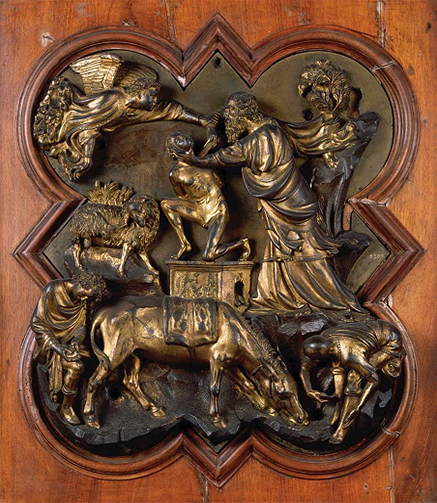
SACRIFICE OF ISAAC (BRUNELLESCHI)
%%**(FIFTEENTH-CENTURY ITALY)**%%
==**(EARLY RENNAISSANCE IN FLORENCE)**==
%%**(FIFTEENTH-CENTURY ITALY)**%%
==**(EARLY RENNAISSANCE IN FLORENCE)**==
* Filippo Brunelleschi
* 1401–1402.
* Bronze with gilding,
* 21 × 171⁄2″ (53 × 44 cm) inside molding.
* Museo Nazionale del Bargello, Florence
* **The Competition Relief**
* 1401–1402.
* Bronze with gilding,
* 21 × 171⁄2″ (53 × 44 cm) inside molding.
* Museo Nazionale del Bargello, Florence
* **The Competition Relief**
24
New cards
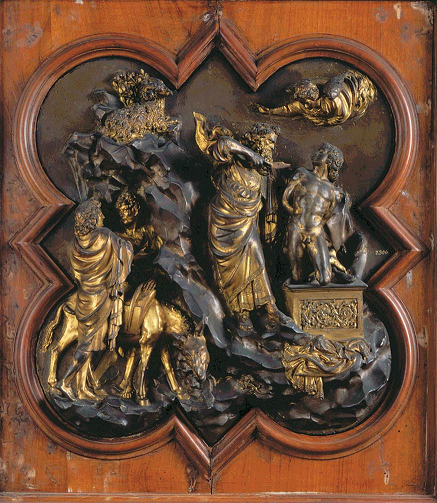
SACRIFICE OF ISAAC (GHIBERTI)
%%**(FIFTEENTH-CENTURY ITALY)**%%
==**(EARLY RENNAISSANCE IN FLORENCE)**==
%%**(FIFTEENTH-CENTURY ITALY)**%%
==**(EARLY RENNAISSANCE IN FLORENCE)**==
* Lorenzo Ghiberti
* 1401–1402.
* Bronze with gilding,
* 21 × 171⁄2″ (53 × 44 cm) inside molding.
* Museo Nazionale del Bargello, Florence.
* **The Competition Relief**
* 1401–1402.
* Bronze with gilding,
* 21 × 171⁄2″ (53 × 44 cm) inside molding.
* Museo Nazionale del Bargello, Florence.
* **The Competition Relief**
25
New cards
Filippo Brunelleschi, Architect
%%**(FIFTEENTH-CENTURY ITALY)**%%
==**(EARLY RENNAISSANCE IN FLORENCE)**==
%%**(FIFTEENTH-CENTURY ITALY)**%%
==**(EARLY RENNAISSANCE IN FLORENCE)**==
The defining civic project of the early years of the fifteenth century was the completion of Florence Cathedral with a magnificent dome over the high altar. The construction of the cathedral had begun in the late thirteenth century and had continued intermittently during the fourteenth. As early as 1367, builders had envisioned a very tall dome to span the huge interior space of the crossing, but they lacked the engineering know-how to construct it. When interest in completing the cathedral revived around 1407, the technical solution was proposed by the young sculptor-turned-architect Filippo Brunelleschi.
26
New cards
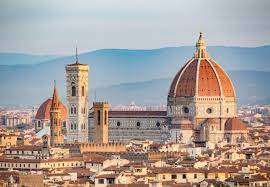
FLORENCE CATHEDRAL / DOME OF FLORENCE CATHEDRAL (SANTA MARIA DEL FIORE)
%%**(FIFTEENTH-CENTURY ITALY)**%%
==**(EARLY RENNAISSANCE IN FLORENCE)**==
%%**(FIFTEENTH-CENTURY ITALY)**%%
==**(EARLY RENNAISSANCE IN FLORENCE)**==
* Filippo Brunelleschi
* 1420–1436; lantern completed 1471.
\
Filippo Brunelleschi (1377– 1446) achieved what many had considered impossible: He solved the problem of the dome of Florence Cathedral. Brunelleschi had originally trained as a goldsmith. To further his education, he traveled to Rome to study ancient Roman sculpture and architecture, and it was on his return to Florence that he tackled the dome. After the completion of a tall octagonal drum in 1412, Brunelleschi designed the dome itself in 1417, and it was built between 1420 and 1436 (FIGS. 20–4, 20–5). A revolutionary feat of engineering, the dome is a double shell of masonry 138 feet across. The octagonal outer shell is supported on 8 large and 16 lighter ribs. Instead of using a costly and even dangerous scaffold and centering, Brunelleschi devised a system in which temporary wooden supports were cantilevered out from the drum. He moved these supports up as building progressed. As the dome was built up course by course, each portion of the structure reinforced the next one. Vertical marble ribs interlocked with horizontal sandstone rings, connected and reinforced with iron rods and oak beams. The inner and outer shells were linked internally by a system of arches. When completed, this self-buttressed unit required no external support to keep it standing. An oculus (round opening) in the center of the dome was topped with a lantern designed in 1436. After Brunelleschi’s death, this crowning structure, made up of Roman architectural forms, was completed by another Florentine architect, Michelozzo di Bartolomeo (1396–1472). The final touch—a gilt-bronze ball by Andrea del Verrocchio—was added in 1468–1471 (but replaced in 1602 with a smaller one). Other commissions came quickly after the cathedral dome project established Brunelleschi’s fame. From about 1418 until his death in 1446, Brunelleschi was involved in a series of influential projects. Between 1419 and 1423, he built the elegant Capponi Chapel in the church of Santa Felicità (SEE FIG. 21–37). In 1419, he also designed a foundling hospital for the city.
* 1420–1436; lantern completed 1471.
\
Filippo Brunelleschi (1377– 1446) achieved what many had considered impossible: He solved the problem of the dome of Florence Cathedral. Brunelleschi had originally trained as a goldsmith. To further his education, he traveled to Rome to study ancient Roman sculpture and architecture, and it was on his return to Florence that he tackled the dome. After the completion of a tall octagonal drum in 1412, Brunelleschi designed the dome itself in 1417, and it was built between 1420 and 1436 (FIGS. 20–4, 20–5). A revolutionary feat of engineering, the dome is a double shell of masonry 138 feet across. The octagonal outer shell is supported on 8 large and 16 lighter ribs. Instead of using a costly and even dangerous scaffold and centering, Brunelleschi devised a system in which temporary wooden supports were cantilevered out from the drum. He moved these supports up as building progressed. As the dome was built up course by course, each portion of the structure reinforced the next one. Vertical marble ribs interlocked with horizontal sandstone rings, connected and reinforced with iron rods and oak beams. The inner and outer shells were linked internally by a system of arches. When completed, this self-buttressed unit required no external support to keep it standing. An oculus (round opening) in the center of the dome was topped with a lantern designed in 1436. After Brunelleschi’s death, this crowning structure, made up of Roman architectural forms, was completed by another Florentine architect, Michelozzo di Bartolomeo (1396–1472). The final touch—a gilt-bronze ball by Andrea del Verrocchio—was added in 1468–1471 (but replaced in 1602 with a smaller one). Other commissions came quickly after the cathedral dome project established Brunelleschi’s fame. From about 1418 until his death in 1446, Brunelleschi was involved in a series of influential projects. Between 1419 and 1423, he built the elegant Capponi Chapel in the church of Santa Felicità (SEE FIG. 21–37). In 1419, he also designed a foundling hospital for the city.
27
New cards
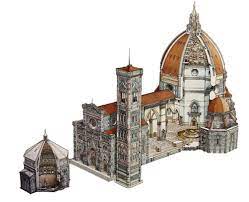
SCHEMATIC DRAWING OF FLORENCE CATHEDRAL
%%**(FIFTEENTH-CENTURY ITALY)**%%
==**(EARLY RENNAISSANCE IN FLORENCE)**==
%%**(FIFTEENTH-CENTURY ITALY)**%%
==**(EARLY RENNAISSANCE IN FLORENCE)**==
* The separate, central-plan building in front of the façade is the baptistery.
* Adjacent to the façade is a tall tower designed by Giotto in 1334.
* Adjacent to the façade is a tall tower designed by Giotto in 1334.
28
New cards
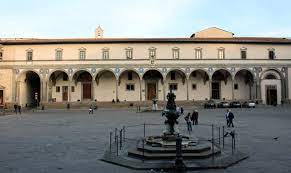
THE FOUNDLING HOSPITAL / OSPEDALE DEGLI INNOCENTI (FOUNDLING HOSPITAL)
%%**(FIFTEENTH-CENTURY ITALY)**%%
==**(EARLY RENNAISSANCE IN FLORENCE)**==
%%**(FIFTEENTH-CENTURY ITALY)**%%
==**(EARLY RENNAISSANCE IN FLORENCE)**==
* Filippo Brunelleschi
* FLORENCE
* Designed 1419; begun under Brunelleschi’s direct supervision 1421–1427; construction continued into the 1440s.
\
In 1419, the guild of silk manufacturers and goldsmiths (Arte della Seta) in Florence undertook a significant public service: It established a large public orphanage and commissioned Filippo Brunelleschi to build it near the church of the Santissima Annunziata (Most Holy Annunciation), which housed a miracle-working painting of the Annunciation, making it a popular pilgrimage site. Completed in 1444, the Foundling Hospital—OSPEDALE DEGLI INNOCENTI—was unprecedented in terms of scale and design (FIG. 20–6). Brunelleschi created a building that paid homage to traditional forms while introducing features that we associate with the Italian Renaissance style. Traditionally, a charitable foundation’s building had a portico open to the street to provide shelter, and Brunelleschi built an arcade of striking lightness and elegance, using smooth round columns and richly carved capitals—his own interpretation of the Classical Corinthian order. Although we might initially assume that the sources for this arcade lay in the Roman architecture of Classical antiquity, columns were not actually used in antiquity to support free-standing arcades, only to support straight architraves. In fact, it was local Romanesque architecture that was the source for Brunelleschi’s design. It is the details of capitals and moldings that bring an air of the antique to this influential building. The underlying mathematical basis for Brunelleschi’s design—traced to the same Pythagorean proportional systems that were believed to create musical harmony—creates a distinct sense of harmony in this graceful arcade. Each bay encloses a cube of space defined by the 10-braccia (20–foot) height of the columns and the diameter of the arches. Domical vaults, half as high again as the columns, cover the cubes. The bays at the end of the arcade are slightly larger than the rest, creating a subtle frame for the composition. Brunelleschi defined the perfect squares and semicircles of his building with pietra serena, a gray Tuscan sandstone, against plain white walls. His training as a goldsmith and sculptor served him well as he led his artisans to carve crisp, elegantly detailed capitals and moldings for the covered gallery.
* FLORENCE
* Designed 1419; begun under Brunelleschi’s direct supervision 1421–1427; construction continued into the 1440s.
\
In 1419, the guild of silk manufacturers and goldsmiths (Arte della Seta) in Florence undertook a significant public service: It established a large public orphanage and commissioned Filippo Brunelleschi to build it near the church of the Santissima Annunziata (Most Holy Annunciation), which housed a miracle-working painting of the Annunciation, making it a popular pilgrimage site. Completed in 1444, the Foundling Hospital—OSPEDALE DEGLI INNOCENTI—was unprecedented in terms of scale and design (FIG. 20–6). Brunelleschi created a building that paid homage to traditional forms while introducing features that we associate with the Italian Renaissance style. Traditionally, a charitable foundation’s building had a portico open to the street to provide shelter, and Brunelleschi built an arcade of striking lightness and elegance, using smooth round columns and richly carved capitals—his own interpretation of the Classical Corinthian order. Although we might initially assume that the sources for this arcade lay in the Roman architecture of Classical antiquity, columns were not actually used in antiquity to support free-standing arcades, only to support straight architraves. In fact, it was local Romanesque architecture that was the source for Brunelleschi’s design. It is the details of capitals and moldings that bring an air of the antique to this influential building. The underlying mathematical basis for Brunelleschi’s design—traced to the same Pythagorean proportional systems that were believed to create musical harmony—creates a distinct sense of harmony in this graceful arcade. Each bay encloses a cube of space defined by the 10-braccia (20–foot) height of the columns and the diameter of the arches. Domical vaults, half as high again as the columns, cover the cubes. The bays at the end of the arcade are slightly larger than the rest, creating a subtle frame for the composition. Brunelleschi defined the perfect squares and semicircles of his building with pietra serena, a gray Tuscan sandstone, against plain white walls. His training as a goldsmith and sculptor served him well as he led his artisans to carve crisp, elegantly detailed capitals and moldings for the covered gallery.
29
New cards
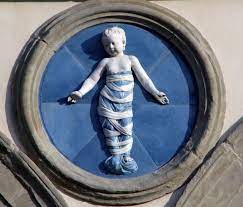
INFANT IN SWADDLING CLOTHES (ONE OF THE HOLY INNOCENTS MASSACRED BY HEROD) Ospedale degli Innocenti (Foundling Hospital)
%%**(FIFTEENTH-CENTURY ITALY)**%%
==**(EARLY RENNAISSANCE IN FLORENCE)**==
%%**(FIFTEENTH-CENTURY ITALY)**%%
==**(EARLY RENNAISSANCE IN FLORENCE)**==
* Andrea della Robbia,
* Florence.
* c. 1487.
* Glazed terra cotta.
\
A later addition to the building seems especially suitable: About 1487, Andrea della Robbia, who had inherited the family ceramics firm and its secret glazing formulas from his uncle Luca, created for the spandrels between the arches glazed terra-cotta medallions (FIG. 20–7) that signified the building’s function. Molds were used in the ceramic workshop to facilitate the production of the series of similar babies in swaddling clothes, one of which was placed at the center of each medallion. The terra-cotta forms were covered with a tin glaze to make the sculptures both weatherproof and decorative, and the baby-blue ceramic backgrounds—a signature color for the della Robbia family workshop—makes the babies seem to float as celestial apparitions. This is not altogether inappropriate. Although they clearly refer to the foundlings (innocenti) cared for in the hospital, they are also meant to evoke the innocent baby boys martyred by King Herod in his attempt to rid his realm of the potential rival the Magi had journeyed to venerate (Matthew 2:16). Andrea della Robbia’s ceramic babies—which remain among the most beloved images of the city of Florence— seem to lay claim to the human side of Renaissance humanism, reminding viewers that the city’s wealthiest guild cared for the most helpless members of society. Perhaps the Foundling Hospital spoke to fifteenth-century Florentines’ increased sense of social responsibility. Or perhaps, by so publicly demonstrating social concerns, the wealthy guild that sponsored the hospital solicited the support of the lower classes in the cut-throat power politics of the day.
* Florence.
* c. 1487.
* Glazed terra cotta.
\
A later addition to the building seems especially suitable: About 1487, Andrea della Robbia, who had inherited the family ceramics firm and its secret glazing formulas from his uncle Luca, created for the spandrels between the arches glazed terra-cotta medallions (FIG. 20–7) that signified the building’s function. Molds were used in the ceramic workshop to facilitate the production of the series of similar babies in swaddling clothes, one of which was placed at the center of each medallion. The terra-cotta forms were covered with a tin glaze to make the sculptures both weatherproof and decorative, and the baby-blue ceramic backgrounds—a signature color for the della Robbia family workshop—makes the babies seem to float as celestial apparitions. This is not altogether inappropriate. Although they clearly refer to the foundlings (innocenti) cared for in the hospital, they are also meant to evoke the innocent baby boys martyred by King Herod in his attempt to rid his realm of the potential rival the Magi had journeyed to venerate (Matthew 2:16). Andrea della Robbia’s ceramic babies—which remain among the most beloved images of the city of Florence— seem to lay claim to the human side of Renaissance humanism, reminding viewers that the city’s wealthiest guild cared for the most helpless members of society. Perhaps the Foundling Hospital spoke to fifteenth-century Florentines’ increased sense of social responsibility. Or perhaps, by so publicly demonstrating social concerns, the wealthy guild that sponsored the hospital solicited the support of the lower classes in the cut-throat power politics of the day.
30
New cards
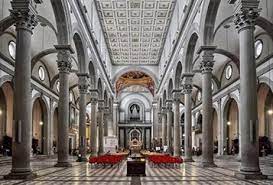
SAN LORENZO / INTERIOR OF CHURCH OF SAN LORENZO, FLORENCE
%%**(FIFTEENTH-CENTURY ITALY)**%%
==**(EARLY RENNAISSANCE IN FLORENCE)**==
%%**(FIFTEENTH-CENTURY ITALY)**%%
==**(EARLY RENNAISSANCE IN FLORENCE)**==
* Filippo Brunelleschi (continued by Michelozzo di Bartolomeo)
* c. 1421–1428; nave (designed 1434?) 1442–1470.
\
For the Medicis’ parish church of San Lorenzo, Brunelleschi designed and built a centrally planned sacristy (a room where ritual attire and vessels are kept) from 1421 to 1428 and also conceived plans for a new church. The church has a basilican plan with a long nave flanked by side aisles that open into shallow lateral chapels (FIG. 20–8). A short transept and square crossing lead to a square sanctuary flanked by additional chapels opening off the transept. Brunelleschi based his mathematically regular plan on a square module—a basic unit of measure that could be multiplied or divided and applied to every element of the design, creating a series of clear, harmonious spaces. Architectural details, all in a Classical style, were carved in the dark gray pietra serena, that became synonymous with Brunelleschi’s interiors. Below the plain clerestory with its unobtrusive openings, the arches of the nave arcade are carried on tall, slender Corinthian columns made even taller by the insertion of an impost block between the column capital and the springing of the round arches—one of Brunelleschi’s favorite details. Flattened architectural moldings in pietra serena repeat the arcade in the outer walls of the side aisles, and each bay is covered by its own shallow domical vault. Brunelleschi’s rational approach, clear sense of order, and innovative incorporation of Classical motifs inspired later Renaissance architects, many of whom learned from his work firsthand by completing his unfinished projects.
* c. 1421–1428; nave (designed 1434?) 1442–1470.
\
For the Medicis’ parish church of San Lorenzo, Brunelleschi designed and built a centrally planned sacristy (a room where ritual attire and vessels are kept) from 1421 to 1428 and also conceived plans for a new church. The church has a basilican plan with a long nave flanked by side aisles that open into shallow lateral chapels (FIG. 20–8). A short transept and square crossing lead to a square sanctuary flanked by additional chapels opening off the transept. Brunelleschi based his mathematically regular plan on a square module—a basic unit of measure that could be multiplied or divided and applied to every element of the design, creating a series of clear, harmonious spaces. Architectural details, all in a Classical style, were carved in the dark gray pietra serena, that became synonymous with Brunelleschi’s interiors. Below the plain clerestory with its unobtrusive openings, the arches of the nave arcade are carried on tall, slender Corinthian columns made even taller by the insertion of an impost block between the column capital and the springing of the round arches—one of Brunelleschi’s favorite details. Flattened architectural moldings in pietra serena repeat the arcade in the outer walls of the side aisles, and each bay is covered by its own shallow domical vault. Brunelleschi’s rational approach, clear sense of order, and innovative incorporation of Classical motifs inspired later Renaissance architects, many of whom learned from his work firsthand by completing his unfinished projects.
31
New cards
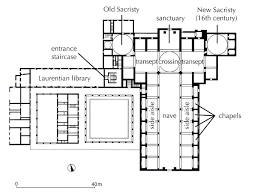
PLAN OF CHURCH OF SAN LORENZO, FLORENCE
%%**(FIFTEENTH-CENTURY ITALY)**%%
==**(EARLY RENNAISSANCE IN FLORENCE)**==
%%**(FIFTEENTH-CENTURY ITALY)**%%
==**(EARLY RENNAISSANCE IN FLORENCE)**==
* Filippo Brunelleschi (continued by Michelozzo di Bartolomeo)
* c. 1421–1428; nave (designed 1434?) 1442–1470
* c. 1421–1428; nave (designed 1434?) 1442–1470
32
New cards
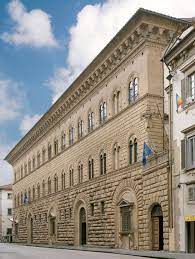
THE MEDICI PALACE / FAÇADE, PALAZZO MEDICI-RICCARDI, FLORENCE
%%**(FIFTEENTH-CENTURY ITALY)**%%
==**(EARLY RENNAISSANCE IN FLORENCE)**==
%%**(FIFTEENTH-CENTURY ITALY)**%%
==**(EARLY RENNAISSANCE IN FLORENCE)**==
* Attributed to Michelozzo di Bartolomeo
* Begun 1446 (the view shown here includes a two-bay extension constructed during the 18th century)
\
* For the palace site, Cosimo de’ Medici the Elder chose the Via de’ Gori at the corner of the Via Larga, the widest city street at that time. Despite his practical reasons for constructing a large residence and the fact that he chose simplicity and austerity over grandeur in the exterior design, his detractors commented and gossiped. As one exaggerated, “\[Cosimo\] has begun a palace which throws even the Colosseum at Rome into the shade.”
\
Brunelleschi may have been involved in designing the nearby Medici Palace (now known as the PALAZZO MEDICI-RICCARDI) in 1446. According to Giorgio Vasari, the sixteenth-century artist and theorist who wrote the first modern history of art, Cosimo de’ Medici the Elder rejected Brunelleschi’s model for the palazzo as too grand (any large house was called a palazzo—“palace”). Many now attribute the design of the building to Michelozzo. The austere exterior (FIG. 20–9) was in keeping with the Florentine political climate and religious attitudes, both imbued with the Franciscan ideals of poverty and charity. Like many other European cities, Florence had sumptuary laws that forbade ostentatious displays of wealth—but they were often ignored. For example, private homes were supposed to be limited to a dozen rooms, but Cosimo acquired and demolished 20 small houses to provide the site for his new residence. His house was more than a dwelling place; it was his place of business, his company headquarters. The palazzo symbolized the family and established its place in the Florentine social hierarchy. Huge in scale—each story is more than 20 feet high— the building is marked by harmonious proportions and elegant, Classically inspired details. On one side, the ground floor originally opened through large, round arches onto the street, creating in effect a loggia that provided space for the family business. These arches were walled up in the sixteenth century and given windows designed by Michelangelo. The large, rusticated stone blocks—that is, blocks with their outer faces left rough—facing the lower story clearly set it off from the upper two levels. In fact, all three stories are distinguished by stone surfaces that vary from sculptural at the ground level to almost smooth dressed stone on the third floor. The builders followed the time-honored tradition of placing rooms around a central courtyard. Unlike the plan of the house of Jacques Coeur (SEE FIG. 19–24A), however, the Palazzo Medici-Riccardi courtyard is square in plan with rooms arranged symmetrically (FIG. 20–10). Round arches on slender columns form a continuous arcade under an enclosed second story. Disks bearing the Medici arms top each arch in a frieze decorated with swags in sgraffito work (decoration produced by scratching through a darker layer of plaster or glaze). Such classicizing elements, inspired by the study of Roman ruins, gave the great house an aura of dignity and stability that enhanced the status of its owners. The Medici Palace inaugurated a new fashion for monumentality and regularity in residential Florentine architecture.
* Begun 1446 (the view shown here includes a two-bay extension constructed during the 18th century)
\
* For the palace site, Cosimo de’ Medici the Elder chose the Via de’ Gori at the corner of the Via Larga, the widest city street at that time. Despite his practical reasons for constructing a large residence and the fact that he chose simplicity and austerity over grandeur in the exterior design, his detractors commented and gossiped. As one exaggerated, “\[Cosimo\] has begun a palace which throws even the Colosseum at Rome into the shade.”
\
Brunelleschi may have been involved in designing the nearby Medici Palace (now known as the PALAZZO MEDICI-RICCARDI) in 1446. According to Giorgio Vasari, the sixteenth-century artist and theorist who wrote the first modern history of art, Cosimo de’ Medici the Elder rejected Brunelleschi’s model for the palazzo as too grand (any large house was called a palazzo—“palace”). Many now attribute the design of the building to Michelozzo. The austere exterior (FIG. 20–9) was in keeping with the Florentine political climate and religious attitudes, both imbued with the Franciscan ideals of poverty and charity. Like many other European cities, Florence had sumptuary laws that forbade ostentatious displays of wealth—but they were often ignored. For example, private homes were supposed to be limited to a dozen rooms, but Cosimo acquired and demolished 20 small houses to provide the site for his new residence. His house was more than a dwelling place; it was his place of business, his company headquarters. The palazzo symbolized the family and established its place in the Florentine social hierarchy. Huge in scale—each story is more than 20 feet high— the building is marked by harmonious proportions and elegant, Classically inspired details. On one side, the ground floor originally opened through large, round arches onto the street, creating in effect a loggia that provided space for the family business. These arches were walled up in the sixteenth century and given windows designed by Michelangelo. The large, rusticated stone blocks—that is, blocks with their outer faces left rough—facing the lower story clearly set it off from the upper two levels. In fact, all three stories are distinguished by stone surfaces that vary from sculptural at the ground level to almost smooth dressed stone on the third floor. The builders followed the time-honored tradition of placing rooms around a central courtyard. Unlike the plan of the house of Jacques Coeur (SEE FIG. 19–24A), however, the Palazzo Medici-Riccardi courtyard is square in plan with rooms arranged symmetrically (FIG. 20–10). Round arches on slender columns form a continuous arcade under an enclosed second story. Disks bearing the Medici arms top each arch in a frieze decorated with swags in sgraffito work (decoration produced by scratching through a darker layer of plaster or glaze). Such classicizing elements, inspired by the study of Roman ruins, gave the great house an aura of dignity and stability that enhanced the status of its owners. The Medici Palace inaugurated a new fashion for monumentality and regularity in residential Florentine architecture.
33
New cards
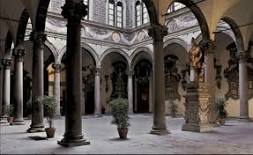
COURTYARD WITH SGRAFFITO DECORATION, PALAZZO MEDICI-RICCARDI
%%**(FIFTEENTH-CENTURY ITALY)**%%
==**(EARLY RENNAISSANCE IN FLORENCE)**==
%%**(FIFTEENTH-CENTURY ITALY)**%%
==**(EARLY RENNAISSANCE IN FLORENCE)**==
* FLORENCE
* Begun 1446.
* Begun 1446.
34
New cards
Sculpture
%%**(FIFTEENTH-CENTURY ITALY)**%%
==**(EARLY RENNAISSANCE IN FLORENCE)**==
%%**(FIFTEENTH-CENTURY ITALY)**%%
==**(EARLY RENNAISSANCE IN FLORENCE)**==
The new architectural language inspired by ancient Classical forms was accompanied by a similar impulse in sculpture. By 1400, Florence had enjoyed internal stability and economic prosperity for over two decades. However, until 1428, the city and its independence were challenged by two great anti-republican powers: the duchy of Milan and the kingdom of Naples. In an atmosphere of wealth and civic patriotism, Florentines turned to commissions that would express their self-esteem and magnify the importance of their city. A new attitude toward realism, space, and the Classical past set the stage for more than a century of creativity. Sculptors led the way.
35
New cards
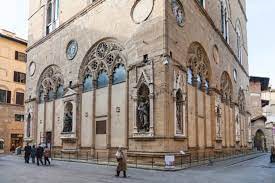
ORSANMICHELE / EXTERIOR VIEW OF ORSANMICHELE SHOWING SCULPTURE IN NICHES
%%**(FIFTEENTH-CENTURY ITALY)**%%
==**(EARLY RENNAISSANCE IN FLORENCE)**==
%%**(FIFTEENTH-CENTURY ITALY)**%%
==**(EARLY RENNAISSANCE IN FLORENCE)**==
* Florence.
* Begun 1337.
\
* At street level, Orsanmichele was constructed originally as an open loggia (similar to the Loggia dei Lanzi in FIG. 18–2); in 1380 the spaces under the arches were filled in. In this view of the southeast corner, appearing on the receding wall to the left is first (in the foreground on the corner pier) Donatello’s St. George, then, Nanni di Banco’s Four Crowned Martyrs. However, the sculptures seen in this photograph are modern replicas; the originals have been removed to museums for safekeeping.
\
In 1339, 14 of Florence’s most powerful guilds had been commissioned to fill the ground-floor niches that decorated the exterior of ORSANMICHELE—a newly completed loggia that served as a grain market— with sculpted images of their patron saints (FIG. 20–11). By 1400, only three had fulfilled this assignment. In the new climate of republicanism and civic pride, the government pressured the guilds to fill their niches. This directive resulted in a dazzling display of sculpture produced by the most impressive local practitioners, including Nanni di Banco, Lorenzo Ghiberti, and Donatello, each of whom took responsibility for filling three niches.
* Begun 1337.
\
* At street level, Orsanmichele was constructed originally as an open loggia (similar to the Loggia dei Lanzi in FIG. 18–2); in 1380 the spaces under the arches were filled in. In this view of the southeast corner, appearing on the receding wall to the left is first (in the foreground on the corner pier) Donatello’s St. George, then, Nanni di Banco’s Four Crowned Martyrs. However, the sculptures seen in this photograph are modern replicas; the originals have been removed to museums for safekeeping.
\
In 1339, 14 of Florence’s most powerful guilds had been commissioned to fill the ground-floor niches that decorated the exterior of ORSANMICHELE—a newly completed loggia that served as a grain market— with sculpted images of their patron saints (FIG. 20–11). By 1400, only three had fulfilled this assignment. In the new climate of republicanism and civic pride, the government pressured the guilds to fill their niches. This directive resulted in a dazzling display of sculpture produced by the most impressive local practitioners, including Nanni di Banco, Lorenzo Ghiberti, and Donatello, each of whom took responsibility for filling three niches.
36
New cards
DONATELLO
%%**(FIFTEENTH-CENTURY ITALY)**%%
==**(EARLY RENNAISSANCE IN FLORENCE)**==
%%**(FIFTEENTH-CENTURY ITALY)**%%
==**(EARLY RENNAISSANCE IN FLORENCE)**==
Donatello (Donato di Niccolò di Betto Bardi, c. 1386/1387–1466) also received three commissions for the niches at Orsanmichele during the first quarter of the century. Like Nanni a member of the guild of stonecarvers and woodworkers, he worked in both media, as well as in bronze. During a long and productive career, he developed into one of the most influential and distinguished figures in the history of Italian sculpture, approaching each commission as if it were the opportunity for a new experiment.
37
New cards
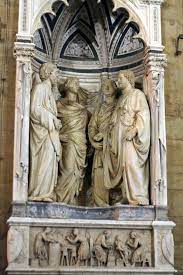
THE FOUR CROWNED MARTYRS
%%**(FIFTEENTH-CENTURY ITALY)**%%
==**(EARLY RENNAISSANCE IN FLORENCE)**==
%%**(FIFTEENTH-CENTURY ITALY)**%%
==**(EARLY RENNAISSANCE IN FLORENCE)**==
* Nanni di Banco
* c. 1409–1417.
* Marble,
* height of figures 6′ (1.83 m).
* Photographed in situ before removal of the figures to the Museo di Orsanmichele, Florence
\
In about 1409, Nanni di Banco (c. 1385–1421), son of a sculptor in the Florence Cathedral workshop, was commissioned by the stonecarver and woodworkers’ guild (to which he himself belonged) to produce THE FOUR CROWNED MARTYRS (FIG. 20–12). According to tradition, these third- or fourth-century Christian martyrs were sculptors executed for refusing to make an image of a pagan Roman god for Emperor Diocletian. Although the architectural setting is Gothic in style, Nanni’s figures—with their solid bodies, heavy yet form-revealing togas, noble hair and beards, and portraitlike features— reveal his interest in ancient Roman sculpture, particularly portraiture (SEE FIG. 6–15). They testify to this sculptor’s role in the Florentine revival of interest in antiquity. The saints convey a new spatial relationship to the building and to the viewer. They stand in a semicircle, with feet and drapery protruding beyond the floor of the niche and into the viewer’s space. The saints appear to be four individuals interacting within their own world, but a world that opens to engage with passing pedestrians (SEE FIG. 20–11). The relief panel below the niche shows the four sculptors at work, embodied with a similar solid vigor. Nanni deeply undercut both figures and objects to cast shadows that enhance the illusion of three-dimensionality.
* c. 1409–1417.
* Marble,
* height of figures 6′ (1.83 m).
* Photographed in situ before removal of the figures to the Museo di Orsanmichele, Florence
\
In about 1409, Nanni di Banco (c. 1385–1421), son of a sculptor in the Florence Cathedral workshop, was commissioned by the stonecarver and woodworkers’ guild (to which he himself belonged) to produce THE FOUR CROWNED MARTYRS (FIG. 20–12). According to tradition, these third- or fourth-century Christian martyrs were sculptors executed for refusing to make an image of a pagan Roman god for Emperor Diocletian. Although the architectural setting is Gothic in style, Nanni’s figures—with their solid bodies, heavy yet form-revealing togas, noble hair and beards, and portraitlike features— reveal his interest in ancient Roman sculpture, particularly portraiture (SEE FIG. 6–15). They testify to this sculptor’s role in the Florentine revival of interest in antiquity. The saints convey a new spatial relationship to the building and to the viewer. They stand in a semicircle, with feet and drapery protruding beyond the floor of the niche and into the viewer’s space. The saints appear to be four individuals interacting within their own world, but a world that opens to engage with passing pedestrians (SEE FIG. 20–11). The relief panel below the niche shows the four sculptors at work, embodied with a similar solid vigor. Nanni deeply undercut both figures and objects to cast shadows that enhance the illusion of three-dimensionality.
38
New cards
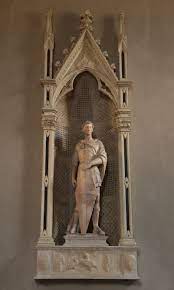
ST. GEORGE
%%**(FIFTEENTH-CENTURY ITALY)**%%
==**(EARLY RENNAISSANCE IN FLORENCE)**==
%%**(FIFTEENTH-CENTURY ITALY)**%%
==**(EARLY RENNAISSANCE IN FLORENCE)**==
* Donatello
* Formerly in Orsanmichele, Florence.
* 1417–1420.
* Marble,
* height 6′5″ (1.95 m).
* Museo Nazionale del Bargello, Florence.
\
One of Florence’s lesser guilds—the armorers and sword-makers—called on Donatello to carve a majestic and self-assured ST. GEORGE for their niche (FIG. 20–13). As originally conceived, the saint would have been a standing advertisement for their trade, carrying a metal sword in his right hand and probably wearing a metal helmet and sporting a scabbard, all now lost. The figure has remarkable presence, even without his accessories. St. George stands in solid defiance, legs braced to support his armor-heavy torso. He seems to stare out into our world, perhaps sizing up his most famous adversary—a dragon that was holding a princess captive—lurking in the space behind us. With his wrinkled brow and determined expression, he is alert and focused, if perhaps also slightly worried. This complex psychological characterization of the warrior-saint particularly impressed Donatello’s contemporaries, not least among them his potential patrons. For the base of the niche, Donatello carved a remarkable shallow relief showing St. George slaying the dragon and saving the princess, a well-known part of his story. The contours of the foreground figures are slightly undercut to emphasize their mass, while the landscape and architecture are in progressively lower relief until they are barely incised rather than carved, an ingenious emulation of the painter’s technique of atmospheric perspective. This is also a pioneering example of linear perspective (see “Renaissance Perspective” on page 623), in which the orthogonals converge on the figure of the saint himself. Donatello used this timely representational system not only to simulate spatial recession, but also to provide narrative focus. Donatello’s long career as a sculptor in a broad variety of media established him as one of the most successful and admired sculptors of the Italian Renaissance. He excelled in part because of his attentive exploration of human emotions and expression, as well as his ability to solve the technical problems posed by various media—from lost-wax casting in bronze and carved marble to polychromed wood.
* Formerly in Orsanmichele, Florence.
* 1417–1420.
* Marble,
* height 6′5″ (1.95 m).
* Museo Nazionale del Bargello, Florence.
\
One of Florence’s lesser guilds—the armorers and sword-makers—called on Donatello to carve a majestic and self-assured ST. GEORGE for their niche (FIG. 20–13). As originally conceived, the saint would have been a standing advertisement for their trade, carrying a metal sword in his right hand and probably wearing a metal helmet and sporting a scabbard, all now lost. The figure has remarkable presence, even without his accessories. St. George stands in solid defiance, legs braced to support his armor-heavy torso. He seems to stare out into our world, perhaps sizing up his most famous adversary—a dragon that was holding a princess captive—lurking in the space behind us. With his wrinkled brow and determined expression, he is alert and focused, if perhaps also slightly worried. This complex psychological characterization of the warrior-saint particularly impressed Donatello’s contemporaries, not least among them his potential patrons. For the base of the niche, Donatello carved a remarkable shallow relief showing St. George slaying the dragon and saving the princess, a well-known part of his story. The contours of the foreground figures are slightly undercut to emphasize their mass, while the landscape and architecture are in progressively lower relief until they are barely incised rather than carved, an ingenious emulation of the painter’s technique of atmospheric perspective. This is also a pioneering example of linear perspective (see “Renaissance Perspective” on page 623), in which the orthogonals converge on the figure of the saint himself. Donatello used this timely representational system not only to simulate spatial recession, but also to provide narrative focus. Donatello’s long career as a sculptor in a broad variety of media established him as one of the most successful and admired sculptors of the Italian Renaissance. He excelled in part because of his attentive exploration of human emotions and expression, as well as his ability to solve the technical problems posed by various media—from lost-wax casting in bronze and carved marble to polychromed wood.
39
New cards
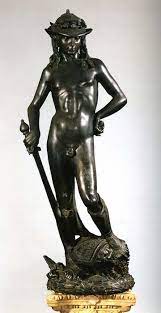
Donatello DAVID
%%**(FIFTEENTH-CENTURY ITALY)**%%
==**(EARLY RENNAISSANCE IN FLORENCE)**==
%%**(FIFTEENTH-CENTURY ITALY)**%%
==**(EARLY RENNAISSANCE IN FLORENCE)**==
* Donatello
* c. 1446–1460 (?).
* Bronze,
* height 5′21⁄4″ (1.58 m).
* Museo Nazionale del Bargello, Florence
\
* This sculpture is first recorded as being in the courtyard of the Medici Palace in 1469, where it stood on a base inscribed with these lines: The victor is whoever defends the fatherland. All-powerful God crushes the angry enemy. Behold, a boy overcomes the great tyrant. Conquer, O citizens!
\
Donatello’s bronze DAVID was the first life-size, freestanding nude since antiquity (FIG. 20–14), Since nothing is known about the circumstances of its creation, this statue has been the subject of continuing inquiry and speculation. Although the representation of David clearly draws on the Classical tradition of heroic nudity, the meaning of this sensuous, pre-pubescent boy in a jaunty, laurel-trimmed shepherd’s hat and boots has long piqued interest. Some art historians have stressed an overt homoeroticism, especially in the openly effeminate conception of David and the way a wing from the helmet on Goliath’s severed head brushes the young hero’s inner thigh. Others have seen in David’s angular pose and boyish torso a sense that he is poised between childish interests and adult responsibility, an image of improbable heroism. David was a potent political image in Florence, a symbol of the citizens’ resolve to oppose tyrants regardless of their superior power, since virtue brings divine support and preternatural strength, and we will see other Florentine Renaissance renderings of this biblical hero. Indeed, an inscription engraved into the base where the sculpture once stood suggests that it could have celebrated the Florentine triumph over the Milanese in 1425, a victory that brought resolution to a quarter-century struggle with despots and helped give Florence a vision of itself as a strong, virtuous republic.
* c. 1446–1460 (?).
* Bronze,
* height 5′21⁄4″ (1.58 m).
* Museo Nazionale del Bargello, Florence
\
* This sculpture is first recorded as being in the courtyard of the Medici Palace in 1469, where it stood on a base inscribed with these lines: The victor is whoever defends the fatherland. All-powerful God crushes the angry enemy. Behold, a boy overcomes the great tyrant. Conquer, O citizens!
\
Donatello’s bronze DAVID was the first life-size, freestanding nude since antiquity (FIG. 20–14), Since nothing is known about the circumstances of its creation, this statue has been the subject of continuing inquiry and speculation. Although the representation of David clearly draws on the Classical tradition of heroic nudity, the meaning of this sensuous, pre-pubescent boy in a jaunty, laurel-trimmed shepherd’s hat and boots has long piqued interest. Some art historians have stressed an overt homoeroticism, especially in the openly effeminate conception of David and the way a wing from the helmet on Goliath’s severed head brushes the young hero’s inner thigh. Others have seen in David’s angular pose and boyish torso a sense that he is poised between childish interests and adult responsibility, an image of improbable heroism. David was a potent political image in Florence, a symbol of the citizens’ resolve to oppose tyrants regardless of their superior power, since virtue brings divine support and preternatural strength, and we will see other Florentine Renaissance renderings of this biblical hero. Indeed, an inscription engraved into the base where the sculpture once stood suggests that it could have celebrated the Florentine triumph over the Milanese in 1425, a victory that brought resolution to a quarter-century struggle with despots and helped give Florence a vision of itself as a strong, virtuous republic.
40
New cards
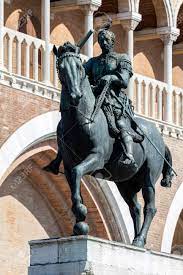
EQUESTRIAN STATUE OF ERASMO DA NARNI (GATTAMELATA)
%%**(FIFTEENTH-CENTURY ITALY)**%%
==**(EARLY RENNAISSANCE IN FLORENCE)**==
%%**(FIFTEENTH-CENTURY ITALY)**%%
==**(EARLY RENNAISSANCE IN FLORENCE)**==
* Donatello
* Piazza del Santo, Padua.
* 1443–1453.
* Bronze,
* height approx. 12′2″ (3.71 m)
\
Probably in 1443, Donatello traveled to Padua to execute one of the first life-size bronze equestrian portraits of the Renaissance—an EQUESTRIAN STATUE (FIG. 20–15) commemorating the Paduan general of the Venetian army, Erasmo da Narni, nicknamed “Gattamelata” (meaning “Honeyed Cat”—a reference to his mother, Melania Gattelli). If any image could be said to characterize the selfmade men of the Italian Renaissance, surely it would be those of the condottieri—the brilliant generals such as Gattamelata and Niccolò da Tolentino (SEE FIG. 20–1) who organized the armies and fought for any city-state willing to pay for their services. As guardians for hire, they were tough, opportunistic mercenaries. But they also subscribed to an ideal of military and civic virtue. Horsemanship was more than a necessary skill for the condottieri. The horse, a beast of enormous strength, symbolized animal passions, and skilled horsemanship demonstrated physical and intellectual control—self-control, as well as control of the animal—the triumph of “mind over matter.” Donatello’s sources for this statue were surviving Roman bronze equestrian portraits, notably the famous image of Marcus Aurelius (SEE FIG. 6–56), which the sculptor certainly knew from his stay in Rome, and the famous set of Roman bronze horses installed on the façade of St. Mark’s Cathedral in Venice. Viewed from a distance, Donatello’s man–animal juggernaut, installed on a high marble base in front of the church of Sant’Antonio in Padua, seems capable of thrusting forward at the first threat. Seen up close, however, the man’s sunken cheeks, sagging jaw, ropy neck, and stern but sad expression suggest a warrior grown old and tired from the constant need for military vigilance and rapid response.
* Piazza del Santo, Padua.
* 1443–1453.
* Bronze,
* height approx. 12′2″ (3.71 m)
\
Probably in 1443, Donatello traveled to Padua to execute one of the first life-size bronze equestrian portraits of the Renaissance—an EQUESTRIAN STATUE (FIG. 20–15) commemorating the Paduan general of the Venetian army, Erasmo da Narni, nicknamed “Gattamelata” (meaning “Honeyed Cat”—a reference to his mother, Melania Gattelli). If any image could be said to characterize the selfmade men of the Italian Renaissance, surely it would be those of the condottieri—the brilliant generals such as Gattamelata and Niccolò da Tolentino (SEE FIG. 20–1) who organized the armies and fought for any city-state willing to pay for their services. As guardians for hire, they were tough, opportunistic mercenaries. But they also subscribed to an ideal of military and civic virtue. Horsemanship was more than a necessary skill for the condottieri. The horse, a beast of enormous strength, symbolized animal passions, and skilled horsemanship demonstrated physical and intellectual control—self-control, as well as control of the animal—the triumph of “mind over matter.” Donatello’s sources for this statue were surviving Roman bronze equestrian portraits, notably the famous image of Marcus Aurelius (SEE FIG. 6–56), which the sculptor certainly knew from his stay in Rome, and the famous set of Roman bronze horses installed on the façade of St. Mark’s Cathedral in Venice. Viewed from a distance, Donatello’s man–animal juggernaut, installed on a high marble base in front of the church of Sant’Antonio in Padua, seems capable of thrusting forward at the first threat. Seen up close, however, the man’s sunken cheeks, sagging jaw, ropy neck, and stern but sad expression suggest a warrior grown old and tired from the constant need for military vigilance and rapid response.
41
New cards
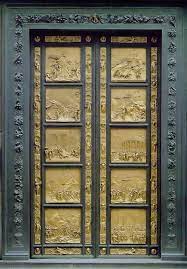
“GATES OF PARADISE” (EAST BAPTISTERY DOORS)
%%**(FIFTEENTH-CENTURY ITALY)**%%
==**(EARLY RENNAISSANCE IN FLORENCE)**==
%%**(FIFTEENTH-CENTURY ITALY)**%%
==**(EARLY RENNAISSANCE IN FLORENCE)**==
* Lorenzo Ghiberti
* Formerly on the Baptistery of San Giovanni, Florence.
* 1425–1452.
* Gilt bronze,
* height 15′ (4.57 m).
* Museo dell’Opera del Duomo, Florence.
\
The door panels, commissioned by the wool manufacturers’ guild, depict ten scenes from the Hebrew Bible beginning with the Creation in the upper left panel. The murder of Abel by his brother, Cain, follows in the upper right panel, succeeded in the same left–right paired order by the Flood and the drunkenness of Noah, Abraham sacrificing Isaac; the story of Jacob and Esau, Joseph sold into slavery by his brothers; Moses receiving the Tablets of the Law, Joshua and the fall of Jericho; and finally David and Goliath, Solomon and the queen of Sheba. Ghiberti placed his own portrait as a signature in the frame at the lower right corner of the Jacob and Esau panel. He wrote in his Commentaries (c. 1450–1455): “I strove to imitate nature as clearly as I could, and with all the perspective I could produce, to have excellent compositions with many figures.”
\
GHIBERTI’S GATES OF PARADISE The bronze doors that Lorenzo Ghiberti (1381?–1455) produced for the Florentine Baptistery after winning his famous competition with Brunelleschi in 1401 were such a success that in 1425 he was awarded the commission for yet another set of bronze doors for the east side of the baptistery, facing the doors of the cathedral; his first set of doors was moved to the north side. The new door panels, funded by the wool manufacturers’ guild, were a significant conceptual leap from the older schemes of 28 small scenes employed for Ghiberti’s earlier doors and those of Andrea Pisano in the fourteenth century (SEE FIG. 18–3). Ghiberti departed entirely from the old arrangement, producing a set of ten scenes from the Hebrew Bible—from the Creation to the reign of Solomon—composed in rectangular fields, like a set of framed paintings. Michelangelo reportedly said that the results, installed in 1452, were worthy of the “GATES OF PARADISE”—the name by which they are now commonly known (FIG. 20–16). Ghiberti organized the space in the ten square reliefs either by a system of linear perspective with obvious orthogonal lines (see “Renaissance Perspective” on page 623) or more intuitively by a series of arches, rocks, or trees charting a path into the distance. Foreground figures are grouped in the lower third of each panel, while the other figures decrease gradually in size to map their positioning in deep space. The use of a system of perspective, with clearly differentiated background and foreground, also helped Ghiberti combine a series of related events, separated by narrative time, within a single pictorial frame.
* Formerly on the Baptistery of San Giovanni, Florence.
* 1425–1452.
* Gilt bronze,
* height 15′ (4.57 m).
* Museo dell’Opera del Duomo, Florence.
\
The door panels, commissioned by the wool manufacturers’ guild, depict ten scenes from the Hebrew Bible beginning with the Creation in the upper left panel. The murder of Abel by his brother, Cain, follows in the upper right panel, succeeded in the same left–right paired order by the Flood and the drunkenness of Noah, Abraham sacrificing Isaac; the story of Jacob and Esau, Joseph sold into slavery by his brothers; Moses receiving the Tablets of the Law, Joshua and the fall of Jericho; and finally David and Goliath, Solomon and the queen of Sheba. Ghiberti placed his own portrait as a signature in the frame at the lower right corner of the Jacob and Esau panel. He wrote in his Commentaries (c. 1450–1455): “I strove to imitate nature as clearly as I could, and with all the perspective I could produce, to have excellent compositions with many figures.”
\
GHIBERTI’S GATES OF PARADISE The bronze doors that Lorenzo Ghiberti (1381?–1455) produced for the Florentine Baptistery after winning his famous competition with Brunelleschi in 1401 were such a success that in 1425 he was awarded the commission for yet another set of bronze doors for the east side of the baptistery, facing the doors of the cathedral; his first set of doors was moved to the north side. The new door panels, funded by the wool manufacturers’ guild, were a significant conceptual leap from the older schemes of 28 small scenes employed for Ghiberti’s earlier doors and those of Andrea Pisano in the fourteenth century (SEE FIG. 18–3). Ghiberti departed entirely from the old arrangement, producing a set of ten scenes from the Hebrew Bible—from the Creation to the reign of Solomon—composed in rectangular fields, like a set of framed paintings. Michelangelo reportedly said that the results, installed in 1452, were worthy of the “GATES OF PARADISE”—the name by which they are now commonly known (FIG. 20–16). Ghiberti organized the space in the ten square reliefs either by a system of linear perspective with obvious orthogonal lines (see “Renaissance Perspective” on page 623) or more intuitively by a series of arches, rocks, or trees charting a path into the distance. Foreground figures are grouped in the lower third of each panel, while the other figures decrease gradually in size to map their positioning in deep space. The use of a system of perspective, with clearly differentiated background and foreground, also helped Ghiberti combine a series of related events, separated by narrative time, within a single pictorial frame.
42
New cards
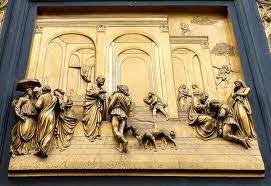
JACOB AND ESAU, PANEL OF THE “GATES OF PARADISE” (EAST BAPTISTERY DOORS)
%%**(FIFTEENTH-CENTURY ITALY)**%%
==**(EARLY RENNAISSANCE IN FLORENCE)**==
%%**(FIFTEENTH-CENTURY ITALY)**%%
==**(EARLY RENNAISSANCE IN FLORENCE)**==
* Lorenzo Ghiberti
* Formerly on the Baptistery of San Giovanni, Florence.
* c. 1435.
* Gilded bronze,
* 311⁄4″ (79 cm) square.
* Museo dell’Opera del Duomo, Florence.
\
The story of JACOB AND ESAU (Genesis 25 and 27) fills the center panel of the left door. Ghiberti creates a coherent and measurable space peopled by graceful, idealized figures (FIG. 20–17). He pays careful attention to one-point perspective in laying out the architectural setting. Squares in the pavement establish the receding lines of the orthogonals that converge on a vanishing point under the loggia, while towering arches overlap and gradually diminish in size from foreground to background to define the receding space above the figures. The story unfolds in a series of individual episodes beginning in the background. On the rooftop (upper right) Rebecca stands, listening as God warns of her unborn sons’ future conflict; under the lefthand arch she gives birth to the twins. The adult Esau sells his rights as oldest son to his brother Jacob, and when he goes hunting (center right), Rebecca and Jacob plot against him. Finally, in the right foreground, Jacob receives Isaac’s blessing, while in the center, Esau faces his father. Ghiberti’s portrayal of the scene relates more closely to developments in painting than to contemporary sculpture. Ghiberti not only signed his work, but also included his self-portrait in the medallion beside the lower right corner of this panel.
* Formerly on the Baptistery of San Giovanni, Florence.
* c. 1435.
* Gilded bronze,
* 311⁄4″ (79 cm) square.
* Museo dell’Opera del Duomo, Florence.
\
The story of JACOB AND ESAU (Genesis 25 and 27) fills the center panel of the left door. Ghiberti creates a coherent and measurable space peopled by graceful, idealized figures (FIG. 20–17). He pays careful attention to one-point perspective in laying out the architectural setting. Squares in the pavement establish the receding lines of the orthogonals that converge on a vanishing point under the loggia, while towering arches overlap and gradually diminish in size from foreground to background to define the receding space above the figures. The story unfolds in a series of individual episodes beginning in the background. On the rooftop (upper right) Rebecca stands, listening as God warns of her unborn sons’ future conflict; under the lefthand arch she gives birth to the twins. The adult Esau sells his rights as oldest son to his brother Jacob, and when he goes hunting (center right), Rebecca and Jacob plot against him. Finally, in the right foreground, Jacob receives Isaac’s blessing, while in the center, Esau faces his father. Ghiberti’s portrayal of the scene relates more closely to developments in painting than to contemporary sculpture. Ghiberti not only signed his work, but also included his self-portrait in the medallion beside the lower right corner of this panel.
43
New cards
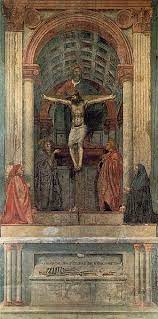
TRINITY WITH THE VIRGIN, ST. JOHN THE EVANGELIST, AND DONORS / holy trinity
%%**(FIFTEENTH-CENTURY ITALY)**%%
==**(EARLY RENNAISSANCE IN FLORENCE)**==
%%**(FIFTEENTH-CENTURY ITALY)**%%
==**(EARLY RENNAISSANCE IN FLORENCE)**==
* Masaccio
Church of Santa Maria Novella, Florence.
* c. 1425–1427/1428.
Fresco,
* 21′ × 10′5″ (6.4 × 3.2 m).
\
Even though his career lasted less than a decade, Tommaso di Ser Giovanni di Mone Cassai (1401–1428/1429?), nicknamed “Masaccio” (meaning “Big Tom”), established a new direction in Florentine painting much as Giotto had a century earlier. He did this by integrating monumental and consistently scaled figures into rational architectural and natural settings using linear perspective. The chronology of Massaccio’s works is uncertain, but his fresco of the TRINITY in the church of Santa Maria Novella in Florence must have been painted around 1426, the date on the Lenzi family tombstone that once stood in front of it (FIGS. 20–18, 20–19). Masaccio’s fresco was meant to give the illusion of a stone funerary monument and altar table set below a deep aedicula (framed niche) in the wall. The effect of looking up into a barrel-vaulted niche was made plausible through precisely rendered linear perspective. The eye level of an adult male viewer standing within the church determined the horizon line on which the vanishing point was centered, just below the kneeling figures above the altar. And the painting demonstrates not only Masaccio’s intimate knowledge of Brunelleschi’s perspective experiments (see “Renaissance Perspective” on page 623), but also his architectural style (SEE FIG. 20–8). The painted architecture is an unusual combination of Classical orders. On the wall surface, Corinthian pilasters support a plain architrave below a cornice, while inside the niche Renaissance variations on Ionic columns support framing arches at the front and rear of the barrel vault. The “source” of the consistent illumination of the architecture lies in front of the picture, casting reflections on the coffers, or sunken panels, of the ceiling. The figures are organized in a measured progression through space. At the near end of the recessed, barrelvaulted space is the Trinity—Jesus on the cross, the dove of the Holy Spirit poised in downward flight above his tilted halo, and God the Father, who stands behind to support the cross from his perch on a high platform. As in many scenes of the Crucifixion, Jesus is flanked by the Virgin Mary and John the Evangelist, who contemplate the scene on either side of the cross. Mary gazes calmly out at us, her raised hand drawing our attention to the Trinity. Members of the Lenzi family kneel in front of the pilasters—thus closer to us than the Crucifixion; the red robes of the male donor signify that he was a member of the governing council of Florence. Below these donors, in an open sarcophagus, is a skeleton, a grim reminder of the Christian belief that since death awaits us all, our only hope is redemption and the promise of life in the hereafter, rooted in Christ’s sacrifice on the cross. The inscription above the skeleton reads: “I was once that which you are, and what I am you also will be.”
Church of Santa Maria Novella, Florence.
* c. 1425–1427/1428.
Fresco,
* 21′ × 10′5″ (6.4 × 3.2 m).
\
Even though his career lasted less than a decade, Tommaso di Ser Giovanni di Mone Cassai (1401–1428/1429?), nicknamed “Masaccio” (meaning “Big Tom”), established a new direction in Florentine painting much as Giotto had a century earlier. He did this by integrating monumental and consistently scaled figures into rational architectural and natural settings using linear perspective. The chronology of Massaccio’s works is uncertain, but his fresco of the TRINITY in the church of Santa Maria Novella in Florence must have been painted around 1426, the date on the Lenzi family tombstone that once stood in front of it (FIGS. 20–18, 20–19). Masaccio’s fresco was meant to give the illusion of a stone funerary monument and altar table set below a deep aedicula (framed niche) in the wall. The effect of looking up into a barrel-vaulted niche was made plausible through precisely rendered linear perspective. The eye level of an adult male viewer standing within the church determined the horizon line on which the vanishing point was centered, just below the kneeling figures above the altar. And the painting demonstrates not only Masaccio’s intimate knowledge of Brunelleschi’s perspective experiments (see “Renaissance Perspective” on page 623), but also his architectural style (SEE FIG. 20–8). The painted architecture is an unusual combination of Classical orders. On the wall surface, Corinthian pilasters support a plain architrave below a cornice, while inside the niche Renaissance variations on Ionic columns support framing arches at the front and rear of the barrel vault. The “source” of the consistent illumination of the architecture lies in front of the picture, casting reflections on the coffers, or sunken panels, of the ceiling. The figures are organized in a measured progression through space. At the near end of the recessed, barrelvaulted space is the Trinity—Jesus on the cross, the dove of the Holy Spirit poised in downward flight above his tilted halo, and God the Father, who stands behind to support the cross from his perch on a high platform. As in many scenes of the Crucifixion, Jesus is flanked by the Virgin Mary and John the Evangelist, who contemplate the scene on either side of the cross. Mary gazes calmly out at us, her raised hand drawing our attention to the Trinity. Members of the Lenzi family kneel in front of the pilasters—thus closer to us than the Crucifixion; the red robes of the male donor signify that he was a member of the governing council of Florence. Below these donors, in an open sarcophagus, is a skeleton, a grim reminder of the Christian belief that since death awaits us all, our only hope is redemption and the promise of life in the hereafter, rooted in Christ’s sacrifice on the cross. The inscription above the skeleton reads: “I was once that which you are, and what I am you also will be.”
44
New cards
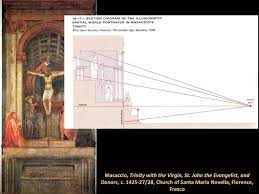
SECTION DIAGRAM OF THE ILLUSIONISTIC SPATIAL WORLD PORTRAYED IN MASACCIO’S TRINITY
%%**(FIFTEENTH-CENTURY ITALY)**%%
==**(EARLY RENNAISSANCE IN FLORENCE)**==
%%**(FIFTEENTH-CENTURY ITALY)**%%
==**(EARLY RENNAISSANCE IN FLORENCE)**==
45
New cards
Technique
RENAISSANCE PERSPECTIVE
%%**(FIFTEENTH-CENTURY ITALY)**%%
==**(EARLY RENNAISSANCE IN FLORENCE)**==
RENAISSANCE PERSPECTIVE
%%**(FIFTEENTH-CENTURY ITALY)**%%
==**(EARLY RENNAISSANCE IN FLORENCE)**==
Fifteenth-century Italian artists developed a system known as linear, or mathematical, perspective that enabled them to represent three dimensions on a two-dimensional surface, simulating the recession of space in the visible world pictorially in a way they found convincing. The sculptor and architect Filippo Brunelleschi first demonstrated the system about 1420, and the theorist and architect Leon Battista Alberti codified it in 1436 in his treatise Della Pittura (On Painting). For Alberti, in one-point linear perspective a picture’s surface was conceived as a flat plane that intersected the viewer’s field of vision at right angles. This highly artificial concept presumed a viewer standing dead center at a prescribed distance from a work of art. From this single fixed vantage point, everything would appear to recede into the distance at the same rate, following imaginary lines called orthogonals that met at a single vanishing point on the horizon. By using orthogonals in concert with controlled diminution of scale as forms move back toward the vanishing point, artists could replicate the optical illusion that things appear to grow smaller, rise higher, and come closer together as they get farther away from us. Linear perspective makes pictorial spaces seem almost like extensions of the viewer’s real space, creating a compelling, even exaggerated sense of depth (FIG. 20–20). Linear perspective is not the only way to simulate spatial recession in two dimensions (see “Pictorial Devices for Depicting Recession in Space” in the Starter Kit on page xviii). In atmospheric perspective, for example, variations in color and clarity convey the feeling of distance: objects and landscape are portrayed less clearly, and colors become grayer, in the background, imitating the natural effects of a loss of clarity and color when viewing things in the distance through an atmospheric haze.
46
New cards
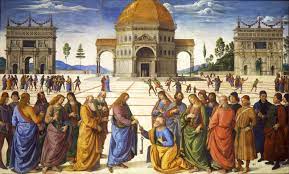
CHRIST GIVING THE KEYS TO ST. PETER
%%**(FIFTEENTH-CENTURY ITALY)**%%
==**(EARLY RENNAISSANCE IN FLORENCE)**==
%%**(FIFTEENTH-CENTURY ITALY)**%%
==**(EARLY RENNAISSANCE IN FLORENCE)**==
* Perugino
* Fresco on the right wall of the Sistine Chapel, Vatican, Rome.
* c. 1480–1482.
* 11′51⁄2″ × 18′81⁄2″ (3.48 × 5.70 m).
\
Perugino’s painting is, among other things, a representation of Alberti’s ideal city, described in De Re Aedificatoria as having a “temple” (that is, a church) at the very center of a great open space, raised on a dais and separate from any other buildings that might obstruct it
* Fresco on the right wall of the Sistine Chapel, Vatican, Rome.
* c. 1480–1482.
* 11′51⁄2″ × 18′81⁄2″ (3.48 × 5.70 m).
\
Perugino’s painting is, among other things, a representation of Alberti’s ideal city, described in De Re Aedificatoria as having a “temple” (that is, a church) at the very center of a great open space, raised on a dais and separate from any other buildings that might obstruct it
47
New cards
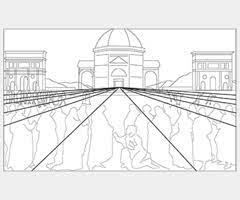
SCHEMATIC DRAWING SHOWING THE ORTHOGONALS AND VANISHING POINT OF CHRIST GIVING THE KEYS TO ST. PETER
%%**(FIFTEENTH-CENTURY ITALY)**%%
==**(EARLY RENNAISSANCE IN FLORENCE)**==
%%**(FIFTEENTH-CENTURY ITALY)**%%
==**(EARLY RENNAISSANCE IN FLORENCE)**==
Christ Giving the Keys to St. Peter is a remarkable study in linear perspective. The clear demarcation of the paving stones of the piazza provides a network of orthogonal and horizontal lines for the measured placement of the figures. People and buildings become systematically smaller as the space recedes. Horizontally, the composition is divided between the foreground frieze of figures and the widely spaced background buildings; it is vertically divided by the open space at the center between Christ and Peter and by the symmetrical architectural forms on either side of this central axis.
48
New cards
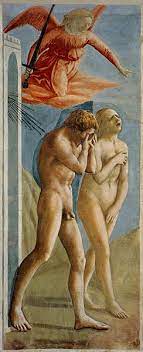
THE EXPULSION OF ADAM AND EVE FROM PARADISE
%%**(FIFTEENTH-CENTURY ITALY)**%%
==**(EARLY RENNAISSANCE IN FLORENCE)**==
%%**(FIFTEENTH-CENTURY ITALY)**%%
==**(EARLY RENNAISSANCE IN FLORENCE)**==
* Masaccio
* Brancacci Chapel, church of Santa Maria del Carmine, Florence.
* c. 1427. Fresco,
* 7′ × 2′11″ (214 × 90 cm)
\
Cleaning and restoration of the Brancacci Chapel paintings revealed the remarkable speed and skill with which Masaccio worked. He painted Adam and Eve in four giornate (each giornata of fresh plaster representing a day’s work). Working from the top down and left to right, he painted the angel on the first day, the portal on the second day, Adam on the third day, and Eve on the fourth.
\
\
* Brancacci Chapel, church of Santa Maria del Carmine, Florence.
* c. 1427. Fresco,
* 7′ × 2′11″ (214 × 90 cm)
\
Cleaning and restoration of the Brancacci Chapel paintings revealed the remarkable speed and skill with which Masaccio worked. He painted Adam and Eve in four giornate (each giornata of fresh plaster representing a day’s work). Working from the top down and left to right, he painted the angel on the first day, the portal on the second day, Adam on the third day, and Eve on the fourth.
\
\
49
New cards
THE BRANCACCI CHAPEL
%%**(FIFTEENTH-CENTURY ITALY)**%%
==**(EARLY RENNAISSANCE IN FLORENCE)**==
%%**(FIFTEENTH-CENTURY ITALY)**%%
==**(EARLY RENNAISSANCE IN FLORENCE)**==
Masaccio’s brief career culminated in the frescos he painted on the walls of the Brancacci Chapel in the church of Santa Maria del Carmine in Florence. Two of the best-known scenes are THE EXPULSION OF ADAM AND EVE FROM PARADISE (FIG. 20–21) and THE TRIBUTE MONEY (FIG. 20–22). In The Expulsion, Masaccio presented Adam and Eve as monumental nude figures, combining his studies of the human figure with an intimate knowledge of ancient Roman sculpture. In contrast to Flemish painters, who sought to record every detail of a figure’s surface (compare Adam and Eve from FIG. 19–13), Masaccio focused on the mass of the bodies formed by the underlying bone and muscle structure; a single light source emphasizes their physicality with modeled forms and cast shadows. Departing from earlier interpretations of the event, which emphasized wrongdoing and the fall from grace, Masaccio concerns himself with the psychological impact of shame on these first humans, who have been cast out of paradise and thrown naked into the world.
50
New cards
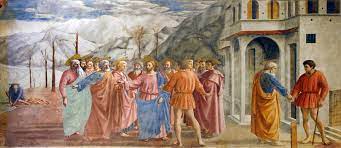
THE TRIBUTE MONEY
%%**(FIFTEENTH-CENTURY ITALY)**%%
==**(EARLY RENNAISSANCE IN FLORENCE)**==
%%**(FIFTEENTH-CENTURY ITALY)**%%
==**(EARLY RENNAISSANCE IN FLORENCE)**==
* Masaccio
* Brancacci Chapel, church of Santa Maria del Carmine, Florence.
* c. 1427.
* Fresco,
* 8′1″ × 19′7″ (2.46 × 6 m).
\
In The Tribute Money (SEE FIG. 20–22), Masaccio portrays an incident from the life of Jesus that highlights St. Peter (Matthew 17:24–27), to whom this chapel was dedicated. In the central scene a tax collector (dressed in a short red tunic and seen from behind) asks Peter (in the left foreground with the short gray beard) if Jesus pays the Jewish temple tax (the “tribute money” of the title). Set against the stable backdrop of a semicircular block of apostolic observers, a masterful series of dynamic diagonals in the postures and gestures of the three main figures interlocks them in a compositional system that gives their interaction a sense of tension calling out for resolution. Jesus instructs Peter to “go to the sea, drop in a hook, and take the first fish that comes up,” which Peter does at the far left. In the fish’s mouth is a coin, which Peter gives to the tax collector at the far right. The tribute story was especially significant for Florentines because in 1427, to raise money for defense against military aggression, the city enacted a graduated tax, based on the value of people’s personal property. The Tribute Money is particularly remarkable for its early use of both linear and atmospheric perspective to integrate figures, architecture, and landscape into a consistent whole. Jesus and the apostles surrounding him form a clear central focus, from which the landscape seems to recede naturally into the far distance. To create this illusion, Masaccio used linear perspective in the depiction of the house, and then reinforced it by diminishing the sizes of the distant trees and the crouching Peter at far left. The central vanishing point established by the orthogonals of the house corresponds with the head of Jesus. The cleaning of the painting in the 1980s revealed that it was painted in 32 giornate (a giornata is a section of fresh plaster that could be prepared and painted in a single day; see “Buon Fresco” in Chapter 18 on page 551). The cleaning also uncovered Masaccio’s subtle use of color to create atmospheric perspective in the distant landscape: Mountains fade from grayish-green to grayish-white, and the houses and trees on their slopes are loosely sketched to simulate the lack of clear definition when viewing things in the distance through a haze. Green leaves were painted on the branches al secco (meaning “on the dry plastered wall”) As in The Expulsion, Masaccio modeled the foreground figures here with bold highlights and long shadows on the ground toward the left, giving a strong sense of volumetric solidity and implying a light source at the far right, as if the scene were lit by the actual window in the rear wall of the Brancacci Chapel. Not only does the lighting give the forms sculptural definition, but the colors also vary in tone according to the strength of the illumination. Masaccio used a wide range of hues—pale pink, mauve, gold, blue-green, seafoam green, apple green, peach— and a sophisticated shading technique using contrasting colors, as in Andrew’s green robe, which is shaded with red instead of darker green. The figures of Jesus and the apostles originally had gold-leaf haloes, several of which have flaked off. Rather than silhouette the heads against consistently flat gold circles (for example, see FIG. 18–6), however, Masaccio conceived of haloes as gold disks hovering in space above each head that moved with the heads as they moved, and he foreshortened them depending on the angle from which each head is seen. Some stylistic innovations take time to be fully accepted, and Masaccio’s innovative depictions of volumetric solidity, consistent lighting, and spatial integration—though they clearly had an impact on his immediate successors—were perhaps best appreciated by a later generation of painters. Many important sixteenth-century Italian artists, including Michelangelo, studied and sketched Masaccio’s Brancacci Chapel frescos, as they did Giotto’s work in the Scrovegni Chapel. In the meantime, painting in Florence after Masaccio’s death developed along somewhat different lines.
* Brancacci Chapel, church of Santa Maria del Carmine, Florence.
* c. 1427.
* Fresco,
* 8′1″ × 19′7″ (2.46 × 6 m).
\
In The Tribute Money (SEE FIG. 20–22), Masaccio portrays an incident from the life of Jesus that highlights St. Peter (Matthew 17:24–27), to whom this chapel was dedicated. In the central scene a tax collector (dressed in a short red tunic and seen from behind) asks Peter (in the left foreground with the short gray beard) if Jesus pays the Jewish temple tax (the “tribute money” of the title). Set against the stable backdrop of a semicircular block of apostolic observers, a masterful series of dynamic diagonals in the postures and gestures of the three main figures interlocks them in a compositional system that gives their interaction a sense of tension calling out for resolution. Jesus instructs Peter to “go to the sea, drop in a hook, and take the first fish that comes up,” which Peter does at the far left. In the fish’s mouth is a coin, which Peter gives to the tax collector at the far right. The tribute story was especially significant for Florentines because in 1427, to raise money for defense against military aggression, the city enacted a graduated tax, based on the value of people’s personal property. The Tribute Money is particularly remarkable for its early use of both linear and atmospheric perspective to integrate figures, architecture, and landscape into a consistent whole. Jesus and the apostles surrounding him form a clear central focus, from which the landscape seems to recede naturally into the far distance. To create this illusion, Masaccio used linear perspective in the depiction of the house, and then reinforced it by diminishing the sizes of the distant trees and the crouching Peter at far left. The central vanishing point established by the orthogonals of the house corresponds with the head of Jesus. The cleaning of the painting in the 1980s revealed that it was painted in 32 giornate (a giornata is a section of fresh plaster that could be prepared and painted in a single day; see “Buon Fresco” in Chapter 18 on page 551). The cleaning also uncovered Masaccio’s subtle use of color to create atmospheric perspective in the distant landscape: Mountains fade from grayish-green to grayish-white, and the houses and trees on their slopes are loosely sketched to simulate the lack of clear definition when viewing things in the distance through a haze. Green leaves were painted on the branches al secco (meaning “on the dry plastered wall”) As in The Expulsion, Masaccio modeled the foreground figures here with bold highlights and long shadows on the ground toward the left, giving a strong sense of volumetric solidity and implying a light source at the far right, as if the scene were lit by the actual window in the rear wall of the Brancacci Chapel. Not only does the lighting give the forms sculptural definition, but the colors also vary in tone according to the strength of the illumination. Masaccio used a wide range of hues—pale pink, mauve, gold, blue-green, seafoam green, apple green, peach— and a sophisticated shading technique using contrasting colors, as in Andrew’s green robe, which is shaded with red instead of darker green. The figures of Jesus and the apostles originally had gold-leaf haloes, several of which have flaked off. Rather than silhouette the heads against consistently flat gold circles (for example, see FIG. 18–6), however, Masaccio conceived of haloes as gold disks hovering in space above each head that moved with the heads as they moved, and he foreshortened them depending on the angle from which each head is seen. Some stylistic innovations take time to be fully accepted, and Masaccio’s innovative depictions of volumetric solidity, consistent lighting, and spatial integration—though they clearly had an impact on his immediate successors—were perhaps best appreciated by a later generation of painters. Many important sixteenth-century Italian artists, including Michelangelo, studied and sketched Masaccio’s Brancacci Chapel frescos, as they did Giotto’s work in the Scrovegni Chapel. In the meantime, painting in Florence after Masaccio’s death developed along somewhat different lines.
51
New cards
Painting in Florence After Masaccio
%%**(FIFTEENTH-CENTURY ITALY)**%%
==**(EARLY RENNAISSANCE IN FLORENCE)**==
%%**(FIFTEENTH-CENTURY ITALY)**%%
==**(EARLY RENNAISSANCE IN FLORENCE)**==
The tradition of covering walls with frescos continued uninterrupted through the fifteenth century. Between 1438 and 1445, Fra Angelico’s decoration of the Dominican monastery of San Marco in Florence was one of the most extensive projects.
52
New cards
FRA ANGELICO
%%**(FIFTEENTH-CENTURY ITALY)**%%
==**(EARLY RENNAISSANCE IN FLORENCE)**==
%%**(FIFTEENTH-CENTURY ITALY)**%%
==**(EARLY RENNAISSANCE IN FLORENCE)**==
Guido di Piero da Mugello (c. 1395/1400–1455) earned his nickname “Fra Angelico” (“Angelic Brother”) through his piety as well as his painting: In 1982, he was beatified, the first step toward sainthood. Fra Angelico is first documented painting in Florence in 1417–1418, and he remained an active painter after taking vows as a Dominican monk in nearby Fiesole between 1418 and 1421. Between 1438 and 1445, in the monastery of San Marco, Fra Angelico and his assistants—probably working under the patronage of Cosimo de’ Medici—created paintings to inspire meditation in each monk’s cell (44 in all; see FIGS. Intro–8, Intro–9), in the chapter house (meeting room), and even in the hallways. At the top of the stairs in the north corridor, where the monks passed frequently on their way to their individual cells, Fra Angelico painted a serene picture of the ANNUNCIATION (FIG. 20–23).
53
New cards
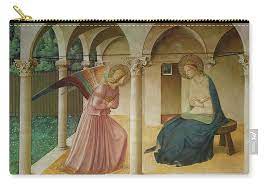
ANNUNCIATION
%%**(FIFTEENTH-CENTURY ITALY)**%%
==**(EARLY RENNAISSANCE IN FLORENCE)**==
%%**(FIFTEENTH-CENTURY ITALY)**%%
==**(EARLY RENNAISSANCE IN FLORENCE)**==
* Fra Angelico
* North dormitory corridor, monastery of San Marco, Florence.
* c. 1438–1445. Fresco,
* 7′1″ × 10′6″ (2.2 × 3.2 m)
\
* The shadowed vault of the portico is supported by a wall on one side and by slender Ionic and Corinthian columns on the other, a new building technique used by Brunelleschi
\
To describe the quiet, measured space where the demure archangel greets the unassuming, youthful Mary, Fra Angelico used linear perspective with striking sensitivity, extending the monks’ stairway and corridor outward into an imagined portico and garden beside the Virgin’s home. The slender, graceful figures wear quietly flowing draperies and assume modest poses. Natural light falling from the left models their forms gently, casting an almost supernatural radiance over their faces and hands. This is a sacred vision rendered in a contemporary setting, welcoming the monks to the most intimate areas of the monastery and preparing them for their private meditations. The line of Latin text running along the bottom of the picture directs the monks, “As you revere this figure of the intact Virgin while passing before it, beware lest you omit to say a Hail Mary.”
* North dormitory corridor, monastery of San Marco, Florence.
* c. 1438–1445. Fresco,
* 7′1″ × 10′6″ (2.2 × 3.2 m)
\
* The shadowed vault of the portico is supported by a wall on one side and by slender Ionic and Corinthian columns on the other, a new building technique used by Brunelleschi
\
To describe the quiet, measured space where the demure archangel greets the unassuming, youthful Mary, Fra Angelico used linear perspective with striking sensitivity, extending the monks’ stairway and corridor outward into an imagined portico and garden beside the Virgin’s home. The slender, graceful figures wear quietly flowing draperies and assume modest poses. Natural light falling from the left models their forms gently, casting an almost supernatural radiance over their faces and hands. This is a sacred vision rendered in a contemporary setting, welcoming the monks to the most intimate areas of the monastery and preparing them for their private meditations. The line of Latin text running along the bottom of the picture directs the monks, “As you revere this figure of the intact Virgin while passing before it, beware lest you omit to say a Hail Mary.”
54
New cards
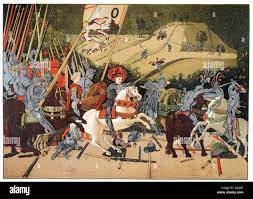
THE BATTLE OF SAN ROMANO
%%**(FIFTEENTH-CENTURY ITALY)**%%
==**(EARLY RENNAISSANCE IN FLORENCE)**==
%%**(FIFTEENTH-CENTURY ITALY)**%%
==**(EARLY RENNAISSANCE IN FLORENCE)**==
* Paolo Uccello
* 1438–1440.
* Tempera on wood panel,
* approx. 6′ × 10′6″ (1.82 × 3.2 m).
* National Gallery, London.
\
UCCELLO At mid century, when Fra Angelico was still painting his radiant visions of Mary and Jesus in the monastery of San Marco, other artists explored different directions. Thoroughly familiar with the theories of Brunelleschi and Alberti, they had mastered the techniques of depicting figures in a constructed architectural space. Paolo Uccello devoted himself with special fervor to the study of linear perspective (FIG. 20–24; see also FIG. 20–1). In his biographies of Italian artists, Vasari described Uccello as a man so obsessed with the science of perspective that he neglected his painting, his family, and even his pet birds (his uccelli). According to Vasari, Uccello’s wife complained that he sat up drawing all night, and when she called to him to come to bed he would say, “Oh, what a sweet thing this perspective is!” (Vasari, trans. Bondanella and Bondanella, p. 83).
* 1438–1440.
* Tempera on wood panel,
* approx. 6′ × 10′6″ (1.82 × 3.2 m).
* National Gallery, London.
\
UCCELLO At mid century, when Fra Angelico was still painting his radiant visions of Mary and Jesus in the monastery of San Marco, other artists explored different directions. Thoroughly familiar with the theories of Brunelleschi and Alberti, they had mastered the techniques of depicting figures in a constructed architectural space. Paolo Uccello devoted himself with special fervor to the study of linear perspective (FIG. 20–24; see also FIG. 20–1). In his biographies of Italian artists, Vasari described Uccello as a man so obsessed with the science of perspective that he neglected his painting, his family, and even his pet birds (his uccelli). According to Vasari, Uccello’s wife complained that he sat up drawing all night, and when she called to him to come to bed he would say, “Oh, what a sweet thing this perspective is!” (Vasari, trans. Bondanella and Bondanella, p. 83).
55
New cards
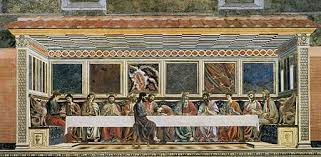
THE LAST SUPPER Refectory
%%**(FIFTEENTH-CENTURY ITALY)**%%
==**(EARLY RENNAISSANCE IN FLORENCE)**==
%%**(FIFTEENTH-CENTURY ITALY)**%%
==**(EARLY RENNAISSANCE IN FLORENCE)**==
* Andrea del Castagno
* convent of Sant’Apollonia, Florence
1447. \
* Fresco,
* width approx. 16 × 32′ (4.6 × 9.8 m).
\
* Castagno worked quickly, completing this huge mural in at most 32 days.
\
Andrea del Castagno (c. 1417/1419–1457) is best known for a fresco of THE LAST SUPPER painted for a convent of Benedictine nuns in 1447 (FIG. 20–25). The subject was often painted in monastic refectories (dining halls) to remind the monks or nuns of Christ’s Last Supper with his first followers and encourage them to see their daily gatherings for meals almost as a sacramental act rooted in this biblical tradition. Here Castagno has not portrayed the scene in the biblical setting of an “upper room.” Rather, the humble house of the original account has become a great palace with sumptuous marble revetment. The most brilliantly colored and wildly patterned marble panel frames the off-center heads of Christ and Judas to focus viewers on the most important part of the picture. Judas takes his traditional position on the viewer’s side of the table, separated from the other apostles. Equally conventional is the seemingly sleeping figure of St. John, head collapsed onto the tabletop (John 13:23). The lines of floor tiles, ceiling rafters, and paneled walls draw viewers into the scene; the nuns would have seen the painting as an extension of their own dining hall. At first, the lines of the orthogonals seem perfectly logical, but close examination reveals that only the lines of the ceiling converge to a single point. Two windows light the painting’s room from the direction of the actual refectory windows, further unifying the two spaces
* convent of Sant’Apollonia, Florence
1447. \
* Fresco,
* width approx. 16 × 32′ (4.6 × 9.8 m).
\
* Castagno worked quickly, completing this huge mural in at most 32 days.
\
Andrea del Castagno (c. 1417/1419–1457) is best known for a fresco of THE LAST SUPPER painted for a convent of Benedictine nuns in 1447 (FIG. 20–25). The subject was often painted in monastic refectories (dining halls) to remind the monks or nuns of Christ’s Last Supper with his first followers and encourage them to see their daily gatherings for meals almost as a sacramental act rooted in this biblical tradition. Here Castagno has not portrayed the scene in the biblical setting of an “upper room.” Rather, the humble house of the original account has become a great palace with sumptuous marble revetment. The most brilliantly colored and wildly patterned marble panel frames the off-center heads of Christ and Judas to focus viewers on the most important part of the picture. Judas takes his traditional position on the viewer’s side of the table, separated from the other apostles. Equally conventional is the seemingly sleeping figure of St. John, head collapsed onto the tabletop (John 13:23). The lines of floor tiles, ceiling rafters, and paneled walls draw viewers into the scene; the nuns would have seen the painting as an extension of their own dining hall. At first, the lines of the orthogonals seem perfectly logical, but close examination reveals that only the lines of the ceiling converge to a single point. Two windows light the painting’s room from the direction of the actual refectory windows, further unifying the two spaces
56
New cards
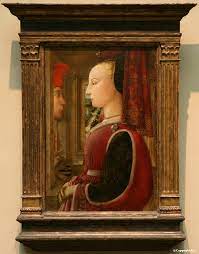
PORTRAIT OF A WOMAN AND MAN (ANGIOLA DI BERNARDO SAPITI AND LORENZO DI RANIERI SCOLARI?)
%%**(FIFTEENTH-CENTURY ITALY)**%%
==**(EARLY RENNAISSANCE IN FLORENCE)**==
%%**(FIFTEENTH-CENTURY ITALY)**%%
==**(EARLY RENNAISSANCE IN FLORENCE)**==
\
* Fra Filippo Lippi
* c. 1435–1445.
* Tempera on wood panel,
* 251⁄4 × 161⁄2″ (64.1 × 41.9 cm).
* Metropolitan Museum of Art, New York.
\
* Some art historians have seen in the sumptuousness of this woman’s costume an indication that she is a newlywed, outfitted in the extravagant clothing and jewelry presented to her by her husband at the time of their marriage, especially since the pearls sewn with gold threads into the embroidery on her sleeve spell out the word lealtà, meaning “loyalty.” Florentine law prevented a woman from wearing such ostentatious expressions of wealth—particularly the jewelry—more than three years after her marriage.
\
FRA FILIPPO LIPPI During the middle of the fifteenth century, portraiture came into its own as a major artistic form in Italy, and among the most extraordinary—if enigmatic—examples is this PORTRAIT OF A WOMAN AND MAN (FIG. 20–26), an early work of Fra Filippo Lippi (c. 1406–1469). This painting is also the earliest surviving double portrait of the Italian Renaissance. Lippi grew up as an orphan in the Carmelite church where Masaccio had painted frescos in the Brancacci Chapel, and art historians have stressed the impact this work had on Lippi’s development as an artist. But although he may have absorbed Masaccio’s predilection for softly rounded forms situated in carefully mapped spaces, in Lippi’s hands these artistic tools became the basis for pictures that often ask more questions than they answer, by stressing outline at the same time as form and creating complex and often confusing spatial systems. The emphasis in this double portrait is squarely on the woman. She is spotlighted in the foreground, sharply profiled against a window that serves as an unsettling internal frame, not big enough to contain her. This window opens onto a vista, clearly a fragment of a larger world, but one that highlights an orthogonal to emphasize a spatial recession only partially revealed. The woman blocks most of this vista with her shining visage and sumptuous costume—notably its embroidered velvet, fur lining, and luminous pearls. There is no engagement with the viewer and little sense of likeness. And it is not at all clear what she is looking at, especially since the gaze of the man in the background does not meet hers. He is even more of a mystery. We see only a masklike sliver of his profile, capped by the red berretta that signals his high status—although the substantiality of his face is reinforced by the strong shadow it casts against the window casement through which he looks. Unlike the woman, who clasps her inert hands in front of her as if to highlight her rings, this man fidgets with his fingers, perhaps to draw our attention to the heraldic device below him that may identify him as a member of the Scolari family. This could be a double portrait of Lorenzo di Ranieri Scolari and Angiola di Bernardo Sapiti, who married in 1436 and welcomed a son in 1444. But what does the painting say about them? Does it commemorate their marriage, celebrate the birth of their child, or memorialize one of their deaths? All have been proposed by art historians as an explanation for this innovative double portrait, but it remains a puzzle to be pondered. Could that pondering be the point of the picture?
* Fra Filippo Lippi
* c. 1435–1445.
* Tempera on wood panel,
* 251⁄4 × 161⁄2″ (64.1 × 41.9 cm).
* Metropolitan Museum of Art, New York.
\
* Some art historians have seen in the sumptuousness of this woman’s costume an indication that she is a newlywed, outfitted in the extravagant clothing and jewelry presented to her by her husband at the time of their marriage, especially since the pearls sewn with gold threads into the embroidery on her sleeve spell out the word lealtà, meaning “loyalty.” Florentine law prevented a woman from wearing such ostentatious expressions of wealth—particularly the jewelry—more than three years after her marriage.
\
FRA FILIPPO LIPPI During the middle of the fifteenth century, portraiture came into its own as a major artistic form in Italy, and among the most extraordinary—if enigmatic—examples is this PORTRAIT OF A WOMAN AND MAN (FIG. 20–26), an early work of Fra Filippo Lippi (c. 1406–1469). This painting is also the earliest surviving double portrait of the Italian Renaissance. Lippi grew up as an orphan in the Carmelite church where Masaccio had painted frescos in the Brancacci Chapel, and art historians have stressed the impact this work had on Lippi’s development as an artist. But although he may have absorbed Masaccio’s predilection for softly rounded forms situated in carefully mapped spaces, in Lippi’s hands these artistic tools became the basis for pictures that often ask more questions than they answer, by stressing outline at the same time as form and creating complex and often confusing spatial systems. The emphasis in this double portrait is squarely on the woman. She is spotlighted in the foreground, sharply profiled against a window that serves as an unsettling internal frame, not big enough to contain her. This window opens onto a vista, clearly a fragment of a larger world, but one that highlights an orthogonal to emphasize a spatial recession only partially revealed. The woman blocks most of this vista with her shining visage and sumptuous costume—notably its embroidered velvet, fur lining, and luminous pearls. There is no engagement with the viewer and little sense of likeness. And it is not at all clear what she is looking at, especially since the gaze of the man in the background does not meet hers. He is even more of a mystery. We see only a masklike sliver of his profile, capped by the red berretta that signals his high status—although the substantiality of his face is reinforced by the strong shadow it casts against the window casement through which he looks. Unlike the woman, who clasps her inert hands in front of her as if to highlight her rings, this man fidgets with his fingers, perhaps to draw our attention to the heraldic device below him that may identify him as a member of the Scolari family. This could be a double portrait of Lorenzo di Ranieri Scolari and Angiola di Bernardo Sapiti, who married in 1436 and welcomed a son in 1444. But what does the painting say about them? Does it commemorate their marriage, celebrate the birth of their child, or memorialize one of their deaths? All have been proposed by art historians as an explanation for this innovative double portrait, but it remains a puzzle to be pondered. Could that pondering be the point of the picture?
57
New cards
Florentine Art in the Second Half of the Fifteenth Century
%%**(FIFTEENTH-CENTURY ITALY)**%%
==**(FLORENTINE ART IN 2ND HALF OF 15TH CENTURY)**==
%%**(FIFTEENTH-CENTURY ITALY)**%%
==**(FLORENTINE ART IN 2ND HALF OF 15TH CENTURY)**==
__***How do Renaissance sculpture and painting continue to develop in Florence during the second half of the fifteenth century?***__
Florence remained a thriving artistic center throughout the fifteenth century. Sculptors continued to explore Classical themes and experiment with the representation of the human form. Florentine painting pursued a love of material opulence, an interest in describing the natural world, and a poetic, mystical spirit, motivated by the patronage of citizens who sought to advertise their wealth and social standing, as well as by the religious fervor that arose at the very end of the century.
Florence remained a thriving artistic center throughout the fifteenth century. Sculptors continued to explore Classical themes and experiment with the representation of the human form. Florentine painting pursued a love of material opulence, an interest in describing the natural world, and a poetic, mystical spirit, motivated by the patronage of citizens who sought to advertise their wealth and social standing, as well as by the religious fervor that arose at the very end of the century.
58
New cards
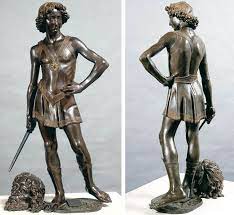
Verrocchio DAVID
%%**(FIFTEENTH-CENTURY ITALY)**%%
==**(FLORENTINE ART IN 2ND HALF OF 15TH CENTURY)**==
%%**(FIFTEENTH-CENTURY ITALY)**%%
==**(FLORENTINE ART IN 2ND HALF OF 15TH CENTURY)**==
* Andrea del Verrocchio
* Commissioned by Lorenzo de’ Medici for the Medici Palace.
* c. 1470–1475.
* Bronze with gilded details,
* height 495⁄8″ (1.26 m).
* Museo Nazionale del Bargello, Florence.
\
Verrocchio One of the most prestigious and active workshops in Florence was that of Andrea di Michele Cioni (1435–1488), nicknamed “Verrocchio” (“true eye”). Trained as a goldsmith, but best known for his works as a painter and bronze sculptor, Verrocchio was also a gifted teacher, counting among his pupils Perugino and Leonardo da Vinci. Around 1470, Lorenzo de’ Medici commissioned a bronze statue of David from Verrocchio for the Palazzo Medici, the location where Donatello’s sculpture of the same subject (SEE FIG. 20–14) was then displayed. Verrocchio’s work (FIG. 20–27) seems to have been conceived as a response to the demure, sleek, but awkwardly boyish nude of his famous predecessor. Verrocchio’s triumphant biblical hero is a poised and proud adolescent, modestly clothed and confidently looking out to meet the gaze of the viewer. Although slight, he is equipped with the developing musculature required for the daunting task—whose accomplishment is signaled by the severed head of his foe, displayed like a trophy between his feet. The careful attention to the textural details of hair and clothing reveal Verrocchio’s training as a goldsmith.
* Commissioned by Lorenzo de’ Medici for the Medici Palace.
* c. 1470–1475.
* Bronze with gilded details,
* height 495⁄8″ (1.26 m).
* Museo Nazionale del Bargello, Florence.
\
Verrocchio One of the most prestigious and active workshops in Florence was that of Andrea di Michele Cioni (1435–1488), nicknamed “Verrocchio” (“true eye”). Trained as a goldsmith, but best known for his works as a painter and bronze sculptor, Verrocchio was also a gifted teacher, counting among his pupils Perugino and Leonardo da Vinci. Around 1470, Lorenzo de’ Medici commissioned a bronze statue of David from Verrocchio for the Palazzo Medici, the location where Donatello’s sculpture of the same subject (SEE FIG. 20–14) was then displayed. Verrocchio’s work (FIG. 20–27) seems to have been conceived as a response to the demure, sleek, but awkwardly boyish nude of his famous predecessor. Verrocchio’s triumphant biblical hero is a poised and proud adolescent, modestly clothed and confidently looking out to meet the gaze of the viewer. Although slight, he is equipped with the developing musculature required for the daunting task—whose accomplishment is signaled by the severed head of his foe, displayed like a trophy between his feet. The careful attention to the textural details of hair and clothing reveal Verrocchio’s training as a goldsmith.
59
New cards
^^Pollaiuolo^^
%%**(FIFTEENTH-CENTURY ITALY)**%%
==**(FLORENTINE ART IN 2ND HALF OF 15TH CENTURY)**==
%%**(FIFTEENTH-CENTURY ITALY)**%%
==**(FLORENTINE ART IN 2ND HALF OF 15TH CENTURY)**==
Florentine sculptors created not only large-scale figures, but also small works. The ambitious and multi-talented Antonio del Pollaiuolo (c. 1431–1498)—a goldsmith, embroidery designer, printmaker, sculptor, and painter who came to work for the Medici family in Florence about 1460—created mostly small bronze sculptures.
60
New cards
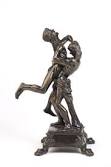
HERCULES AND ANTAEUS
%%**(FIFTEENTH-CENTURY ITALY)**%%
==**(FLORENTINE ART IN 2ND HALF OF 15TH CENTURY)**==
%%**(FIFTEENTH-CENTURY ITALY)**%%
==**(FLORENTINE ART IN 2ND HALF OF 15TH CENTURY)**==
* Antonio del Pollaiuolo
* c. 1475.
* Bronze,
* height with base 18″ (45.7 cm).
* Museo Nazionale del Bargello, Florence.
\
His HERCULES AND ANTAEUS of about 1475 is one of the largest (FIG. 20–28). This study of complex, interlocking figures has an explosive energy that can best be appreciated by viewing it from every angle. Statuettes of religious subjects were still popular, but humanist patrons were beginning to collect bronzes of Classical subjects. Many sculptors, especially those trained as goldsmiths, started to cast small copies of well-known ancient works. Some artists also executed original designs all’antica (“in the antique style”) to appeal to a cultivated humanist taste. Hercules was always a popular figure; as a patron of Florence, he was on the city seal. Among the many courageous acts by which Hercules gained immortality was the slaying of the evil Antaeus in a wrestling match by lifting him off the Earth, the source of the giant’s great physical power.
* c. 1475.
* Bronze,
* height with base 18″ (45.7 cm).
* Museo Nazionale del Bargello, Florence.
\
His HERCULES AND ANTAEUS of about 1475 is one of the largest (FIG. 20–28). This study of complex, interlocking figures has an explosive energy that can best be appreciated by viewing it from every angle. Statuettes of religious subjects were still popular, but humanist patrons were beginning to collect bronzes of Classical subjects. Many sculptors, especially those trained as goldsmiths, started to cast small copies of well-known ancient works. Some artists also executed original designs all’antica (“in the antique style”) to appeal to a cultivated humanist taste. Hercules was always a popular figure; as a patron of Florence, he was on the city seal. Among the many courageous acts by which Hercules gained immortality was the slaying of the evil Antaeus in a wrestling match by lifting him off the Earth, the source of the giant’s great physical power.
61
New cards
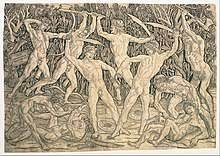
THE BATTLE OF THE NUDES
%%**(FIFTEENTH-CENTURY ITALY)**%%
==**(FLORENTINE ART IN 2ND HALF OF 15TH CENTURY)**==
%%**(FIFTEENTH-CENTURY ITALY)**%%
==**(FLORENTINE ART IN 2ND HALF OF 15TH CENTURY)**==
* Antonio del Pollaiuolo
* c. 1490. Engraving,
* 153⁄4 × 2213⁄16″ (40 × 58 cm).
* Yale University Art Gallery, New Haven, Connecticut. Maitland F. Griggs, B.A. 1896, Fund (1951.9.18).
\
An engraving by Pollaiuolo, THE BATTLE OF THE NUDES (FIG. 20–29), reflects two interests of Renaissance scholars—anatomical research and the study of Classical sculpture. Although this is Pollaiuolo’s only known print, it was still highly influential. He may have intended it as a compositional study of the human figure in action.
The naked men fighting each other ferociously against a tapestrylike background of foliage seem to represent the same individual in a variety of poses, many of which were taken from Classical sources. Like the artist’s Hercules and Antaeus, much of the engraving’s fascination lies in its depiction of the muscles of the male body reacting under tension. This depiction is more impressive than realistic; anatomical accuracy was clearly not the point.
* c. 1490. Engraving,
* 153⁄4 × 2213⁄16″ (40 × 58 cm).
* Yale University Art Gallery, New Haven, Connecticut. Maitland F. Griggs, B.A. 1896, Fund (1951.9.18).
\
An engraving by Pollaiuolo, THE BATTLE OF THE NUDES (FIG. 20–29), reflects two interests of Renaissance scholars—anatomical research and the study of Classical sculpture. Although this is Pollaiuolo’s only known print, it was still highly influential. He may have intended it as a compositional study of the human figure in action.
The naked men fighting each other ferociously against a tapestrylike background of foliage seem to represent the same individual in a variety of poses, many of which were taken from Classical sources. Like the artist’s Hercules and Antaeus, much of the engraving’s fascination lies in its depiction of the muscles of the male body reacting under tension. This depiction is more impressive than realistic; anatomical accuracy was clearly not the point.
62
New cards
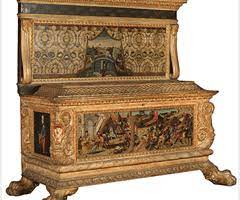
The Morelli-Nerli Wedding Chests / CASSONE MADE FOR THE MARRIAGE OF LORENZO DI MATTEO MORELLI AND VAGGIA DI TANAI NERLI (ONE OF A SET OF TWO)
%%**(FIFTEENTH-CENTURY ITALY)**%%
==**(FLORENTINE ART IN 2ND HALF OF 15TH CENTURY)**==
%%**(FIFTEENTH-CENTURY ITALY)**%%
==**(FLORENTINE ART IN 2ND HALF OF 15TH CENTURY)**==
* Jacopo del Sellaio, Biagio d’Antonio (painters), and Zanobi di Domenico (woodworker)
* 1472.
* Tempera and gold on wood,
* chest 831⁄2 × 75 × 30″ (212 × 193 × 76.2 cm).
* The Samuel Courtauld Trust, the Courtauld Gallery, London. (F.1947.LF.4)
\
The palazzos of wealthy Florentine families were outfitted with massive pieces of elaborate furniture. Constructed of richly carved wood that was gilded and often covered with paintings, these household objects were a central feature of the fifteenth-century Florentine art world. Some of the most impressive surviving examples of Renaissance furniture are great chests—called cassoni—that were used to store clothing and other precious personal objects in a couple’s bedroom. They were frequently commissioned in pairs on the occasion of a wedding. Marriages between members of wealthy Florentine families were not the result of romantic connections between two young people. They were political alliances and economic transactions that involved the transfer of capital and gifts as displays of wealth. In preparation for such marriages, husbands refurbished their living quarters in the family palazzo, where they would bring a bride into the household. We have a detailed accounting of the extent of work required, as well as the expenditure, when 30-year-old Lorenzo di Matteo Morelli prepared his apartments for the arrival of his young bride, Vaggia di Tanai Nerli, after their marriage in 1472. His commissioning of a pair of cassoni—one for him and one for Vaggia—represented almost two-thirds of the entire cost of redecoration. Fortunately, the two chests still survive (FIG. 20–30). They are among the most important and best-preserved Renaissance cassoni that have come down to us, especially since they still maintain the original backboard—called a spalliera—that was produced concurrent with and hung on the wall directly behind the chests when they were placed in Lorenzo’s bedroom. The lion’s feet on which the chests now stand are modern additions, and the spalliera was originally hung as one continuous painting above both cassoni, not two separate panels mounted behind each lid as in the current configuration. Otherwise these chests give a strong sense of their original appearance. Like most Renaissance cassoni, Lorenzo’s chest is painted with pictures drawn from stories that extol moral virtues and reflect some of their values and glories on Lorenzo himself. The long painted scene on the front tells the story of ancient Roman hero Marcus Furius Camillus defeating the Gauls as he chases them out of Rome. On the spalliera, trompe l’oeil (“fool-the-eye”) curtains part to reveal the scene of another Roman hero defending a bridge against insurmountable odds. Presumably Lorenzo wanted to be seen as the heroic descendant of such illustrious Romans—strong, brave, and triumphant. The scenes portrayed on Vaggia’s chest (like Lorenzo’s, identified by her coat of arms) challenge her to care for the children she is expected to produce and to practice the virtues of temperance, prudence, and patience that were valued in Florentine patrician brides. The Morelli–Nerli cassoni passed from Lorenzo to his son, and they remained in the Morelli family at least until 1680, maybe into the nineteenth century, when they first appeared together on the art market. Elaborate Renaissance furniture became coveted items in the homes of wealthy art collectors in late nineteenth-century Europe and America, where the new owners doubtless saw themselves as worthy successors to the rich and powerful merchants who had originally commissioned them.
* 1472.
* Tempera and gold on wood,
* chest 831⁄2 × 75 × 30″ (212 × 193 × 76.2 cm).
* The Samuel Courtauld Trust, the Courtauld Gallery, London. (F.1947.LF.4)
\
The palazzos of wealthy Florentine families were outfitted with massive pieces of elaborate furniture. Constructed of richly carved wood that was gilded and often covered with paintings, these household objects were a central feature of the fifteenth-century Florentine art world. Some of the most impressive surviving examples of Renaissance furniture are great chests—called cassoni—that were used to store clothing and other precious personal objects in a couple’s bedroom. They were frequently commissioned in pairs on the occasion of a wedding. Marriages between members of wealthy Florentine families were not the result of romantic connections between two young people. They were political alliances and economic transactions that involved the transfer of capital and gifts as displays of wealth. In preparation for such marriages, husbands refurbished their living quarters in the family palazzo, where they would bring a bride into the household. We have a detailed accounting of the extent of work required, as well as the expenditure, when 30-year-old Lorenzo di Matteo Morelli prepared his apartments for the arrival of his young bride, Vaggia di Tanai Nerli, after their marriage in 1472. His commissioning of a pair of cassoni—one for him and one for Vaggia—represented almost two-thirds of the entire cost of redecoration. Fortunately, the two chests still survive (FIG. 20–30). They are among the most important and best-preserved Renaissance cassoni that have come down to us, especially since they still maintain the original backboard—called a spalliera—that was produced concurrent with and hung on the wall directly behind the chests when they were placed in Lorenzo’s bedroom. The lion’s feet on which the chests now stand are modern additions, and the spalliera was originally hung as one continuous painting above both cassoni, not two separate panels mounted behind each lid as in the current configuration. Otherwise these chests give a strong sense of their original appearance. Like most Renaissance cassoni, Lorenzo’s chest is painted with pictures drawn from stories that extol moral virtues and reflect some of their values and glories on Lorenzo himself. The long painted scene on the front tells the story of ancient Roman hero Marcus Furius Camillus defeating the Gauls as he chases them out of Rome. On the spalliera, trompe l’oeil (“fool-the-eye”) curtains part to reveal the scene of another Roman hero defending a bridge against insurmountable odds. Presumably Lorenzo wanted to be seen as the heroic descendant of such illustrious Romans—strong, brave, and triumphant. The scenes portrayed on Vaggia’s chest (like Lorenzo’s, identified by her coat of arms) challenge her to care for the children she is expected to produce and to practice the virtues of temperance, prudence, and patience that were valued in Florentine patrician brides. The Morelli–Nerli cassoni passed from Lorenzo to his son, and they remained in the Morelli family at least until 1680, maybe into the nineteenth century, when they first appeared together on the art market. Elaborate Renaissance furniture became coveted items in the homes of wealthy art collectors in late nineteenth-century Europe and America, where the new owners doubtless saw themselves as worthy successors to the rich and powerful merchants who had originally commissioned them.
63
New cards
Ghirlandaio
%%**(FIFTEENTH-CENTURY ITALY)**%%
==**(FLORENTINE ART IN 2ND HALF OF 15TH CENTURY)**==
%%**(FIFTEENTH-CENTURY ITALY)**%%
==**(FLORENTINE ART IN 2ND HALF OF 15TH CENTURY)**==
The most prolific later fifteenth-century Florentine painting workshop was that of Domenico di Tommaso Bigordi (1449–1494), known as “Ghirlandaio” (“Garland-Maker”), a nickname first adopted by his father, who was a goldsmith noted for his floral wreaths. A skilled storyteller, the younger Ghirlandaio reinterpreted the art of earlier fifteenth-century painters into a visual language of descriptive immediacy and structural clarity. Among Ghirlandaio’s most impressive narrative programs was the fresco cycle of the LIFE OF ST. FRANCIS, commissioned by the wealthy manager of the Medici bank, Francesco Sassetti, and painted between 1483 and 1486 on the walls of the Sassetti family burial chapel in the Florentine church of Santa Trinità (FIG. 20–31).
In the uppermost tier of the paintings (FIG. 20–32), Pope Honorius gives a confirmation of the Franciscan order to the kneeling figure of St. Francis, with the Loggia dei Lanzi and the Palazzo della Signoria (SEE FIG. 18–2) in the background. The foreground figures—arranged in a composition that parallels the sacred scene behind them—are portrait likenesses of well-known Florentines. At far right are (from left to right) poet Antonio Pucci, Lorenzo de’ Medici, the patron Francesco Sassetti, and Sassetti’s son Federigo, all of whom seem to be receiving the approaching retinue coming up the stairs at the lower center of the fresco—humanist poet Poliziano leading his pupils, the sons of Lorenzo de’ Medici. Just below this scene, in the middle register (SEE FIG. 20–31), a small boy who has fallen from an upper window is resurrected by St. Francis. This miracle is likewise witnessed by contemporary Florentines, including other members of the Sassetti family and Ghirlandaio himself, and the scene takes place in the piazza outside the actual church of Santa Trinità. Ghirlandaio has thus transferred both events from thirteenth-century Rome to contemporary Florence, painting recognizable views of the city and portraits of living Florentines, and delighting in local color and anecdotal detail. Perhaps Renaissance painters, like Gothic painters, represented sacred narratives in contemporary settings to emphasize their current relevance, or perhaps they and their patrons simply enjoyed seeing themselves dressed in their finery, witnessing these dramas within the cities of which they were justifiably proud.
In the uppermost tier of the paintings (FIG. 20–32), Pope Honorius gives a confirmation of the Franciscan order to the kneeling figure of St. Francis, with the Loggia dei Lanzi and the Palazzo della Signoria (SEE FIG. 18–2) in the background. The foreground figures—arranged in a composition that parallels the sacred scene behind them—are portrait likenesses of well-known Florentines. At far right are (from left to right) poet Antonio Pucci, Lorenzo de’ Medici, the patron Francesco Sassetti, and Sassetti’s son Federigo, all of whom seem to be receiving the approaching retinue coming up the stairs at the lower center of the fresco—humanist poet Poliziano leading his pupils, the sons of Lorenzo de’ Medici. Just below this scene, in the middle register (SEE FIG. 20–31), a small boy who has fallen from an upper window is resurrected by St. Francis. This miracle is likewise witnessed by contemporary Florentines, including other members of the Sassetti family and Ghirlandaio himself, and the scene takes place in the piazza outside the actual church of Santa Trinità. Ghirlandaio has thus transferred both events from thirteenth-century Rome to contemporary Florence, painting recognizable views of the city and portraits of living Florentines, and delighting in local color and anecdotal detail. Perhaps Renaissance painters, like Gothic painters, represented sacred narratives in contemporary settings to emphasize their current relevance, or perhaps they and their patrons simply enjoyed seeing themselves dressed in their finery, witnessing these dramas within the cities of which they were justifiably proud.
64
New cards
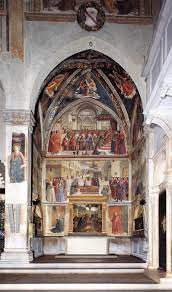
SCENES FROM THE LIFE OF ST. FRANCIS; ALTARPIECE WITH NATIVITY AND ADORATION OF THE SHEPHERDS
%%**(FIFTEENTH-CENTURY ITALY)**%%
==**(FLORENTINE ART IN 2ND HALF OF 15TH CENTURY)**==
%%**(FIFTEENTH-CENTURY ITALY)**%%
==**(FLORENTINE ART IN 2ND HALF OF 15TH CENTURY)**==
* Domenico Ghirlandaio
* Sassetti Chapel, church of Santa Trinità, Florence.
* 1483–1486.
* Fresco,
* chapel 12′2″ deep × 17′2″ wide (3.7 × 5.25)
\
The altarpiece Ghirlandaio painted for the Sassetti Chapel portrays the NATIVITY AND ADORATION OF THE SHEPHERDS (FIG. 20–33). It is still in its original frame in the place for which it was painted (SEE FIG. 20–31). The influence of Hugo van der Goes’s Portinari Altarpiece (SEE FIG. 19–19), which had been placed on the high altar of the church of Sant’Egidio in 1483, two years earlier, is strong. Ghirlandaio’s Christ Child also lies on the ground, adored by the Virgin while rugged shepherds kneel at the right. Ghirlandaio even copies some of Hugo’s flowers—although here the iris, a symbol of the Passion, springs not from a vase, but from the earth in the lower right corner. But Ghirlandaio highlights references to Classical Rome. First to catch the eye are two Classical pilasters with Corinthian capitals, one of which is dated by inscription to 1485. The manger is an ancient sarcophagus with an inscription that promises resurrection (as in the fresco directly above the altarpiece where St. Francis is reviving a child), and in the distance a Classical arch inscribed with a reference to the Roman general Pompey the Great frames the road along which the Magi travel. Weighty, restrained actors replace the psychologically intense figures of Hugo’s painting. Ghirlandaio joins a clear foreground, middle ground, and background in part with the road and in part with aerial perspective, which creates a seamless transition of color from the sharp details and primary hues of the Adoration to the soft gray mountains in the distance.
* Sassetti Chapel, church of Santa Trinità, Florence.
* 1483–1486.
* Fresco,
* chapel 12′2″ deep × 17′2″ wide (3.7 × 5.25)
\
The altarpiece Ghirlandaio painted for the Sassetti Chapel portrays the NATIVITY AND ADORATION OF THE SHEPHERDS (FIG. 20–33). It is still in its original frame in the place for which it was painted (SEE FIG. 20–31). The influence of Hugo van der Goes’s Portinari Altarpiece (SEE FIG. 19–19), which had been placed on the high altar of the church of Sant’Egidio in 1483, two years earlier, is strong. Ghirlandaio’s Christ Child also lies on the ground, adored by the Virgin while rugged shepherds kneel at the right. Ghirlandaio even copies some of Hugo’s flowers—although here the iris, a symbol of the Passion, springs not from a vase, but from the earth in the lower right corner. But Ghirlandaio highlights references to Classical Rome. First to catch the eye are two Classical pilasters with Corinthian capitals, one of which is dated by inscription to 1485. The manger is an ancient sarcophagus with an inscription that promises resurrection (as in the fresco directly above the altarpiece where St. Francis is reviving a child), and in the distance a Classical arch inscribed with a reference to the Roman general Pompey the Great frames the road along which the Magi travel. Weighty, restrained actors replace the psychologically intense figures of Hugo’s painting. Ghirlandaio joins a clear foreground, middle ground, and background in part with the road and in part with aerial perspective, which creates a seamless transition of color from the sharp details and primary hues of the Adoration to the soft gray mountains in the distance.
65
New cards
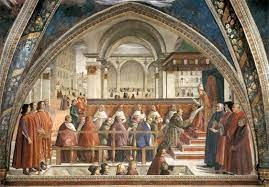
CONFIRMATION OF THE FRANCISCAN RULE BY POPE HONORIUS III
%%**(FIFTEENTH-CENTURY ITALY)**%%
==**(FLORENTINE ART IN 2ND HALF OF 15TH CENTURY)**==
%%**(FIFTEENTH-CENTURY ITALY)**%%
==**(FLORENTINE ART IN 2ND HALF OF 15TH CENTURY)**==
* Domenico Ghirlandaio
* Sassetti Chapel, church of Santa Trinità, Florence.
* 1483–1486.
* Fresco,
* width at base 17′2″ (5.25 m).
* Sassetti Chapel, church of Santa Trinità, Florence.
* 1483–1486.
* Fresco,
* width at base 17′2″ (5.25 m).
66
New cards
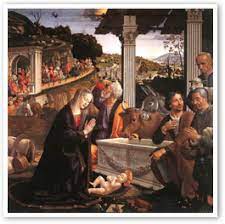
NATIVITY AND ADORATION OF THE SHEPHERDS
%%**(FIFTEENTH-CENTURY ITALY)**%%
==**(FLORENTINE ART IN 2ND HALF OF 15TH CENTURY)**==
%%**(FIFTEENTH-CENTURY ITALY)**%%
==**(FLORENTINE ART IN 2ND HALF OF 15TH CENTURY)**==
* Domenico Ghirlandaio
* Altarpiece in the Sassetti Chapel, church of Santa Trinità, Florence.
* 1485.
* Panel, 653⁄4″ (1.67 m) square.
* Altarpiece in the Sassetti Chapel, church of Santa Trinità, Florence.
* 1485.
* Panel, 653⁄4″ (1.67 m) square.
67
New cards
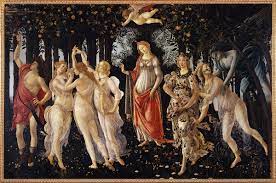
A Closer Look
PRIMAVERA
%%**(FIFTEENTH-CENTURY ITALY)**%%
==**(FLORENTINE ART IN 2ND HALF OF 15TH CENTURY)**==
PRIMAVERA
%%**(FIFTEENTH-CENTURY ITALY)**%%
==**(FLORENTINE ART IN 2ND HALF OF 15TH CENTURY)**==
* Sandro Botticelli
* c. 1482.
* Tempera on wood panel,
* 6′8″ × 10′4″ (2.03 × 3.15 m).
* Galleria degli Uffizi, Florence.
* c. 1482.
* Tempera on wood panel,
* 6′8″ × 10′4″ (2.03 × 3.15 m).
* Galleria degli Uffizi, Florence.
68
New cards
Botticelli
%%**(FIFTEENTH-CENTURY ITALY)**%%
==**(FLORENTINE ART IN 2ND HALF OF 15TH CENTURY)**==
%%**(FIFTEENTH-CENTURY ITALY)**%%
==**(FLORENTINE ART IN 2ND HALF OF 15TH CENTURY)**==
Like most artists in the second half of the fifteenth century, Alessandro di Mariano di Vanni Filipepi (1445–1510), called “Botticelli” (“the little barrel,” a nickname borrowed from his older brother), painted sculptural figures that were modeled by light from a consistent source and placed in a setting rendered illusionistic by linear perspective. An outstanding portraitist, he, like Ghirlandaio, often included recognizable contemporary figures among the saints and angels in religious paintings. He worked in Florence, frequently for the Medici, before being called to Rome in 1481 by Pope Sixtus IV to help decorate the new Sistine Chapel along with Ghirlandaio, Perugino, and other artists. Botticelli returned to Florence that same year and entered a new phase of his career. Like other artists working for patrons steeped in Classical scholarship and humanistic thought, he was exposed to philosophical speculations on beauty—as well as to the examples of ancient art in his employers’ collections. For the Medici, Botticelli produced secular paintings of mythological subjects inspired by ancient works and by contemporary Neoplatonic thought. Art historian Michael Baxandall has shown that these works were also patterned on the slow movements of fifteenth-century Florentine dance, in which the dancers acted out their relationships to one another in public performances that would have influenced the thinking and viewing habits of both painters and their audience. The overall appearance of Botticelli’s PRIMAVERA, or Spring (see “Closer Look” opposite), recalls Flemish tapestries (SEE FIG. 19–8), which were very popular in Italy at the time. And its subject—like the subjects of many tapestries—is a highly complex allegory (a symbolic illustration of a concept or principle) interweaving Neoplatonic ideas with esoteric references to Classical sources. In simple terms, Neoplatonic philosophers and poets conceived Venus, the goddess of love, as having two natures. The first ruled over earthly, human love and the second over universal, divine love. In this way the philosophers could argue that Venus was a Classical equivalent of the Virgin Mary. Primavera was painted at the time of the wedding of Lorenzo di Pierfrancesco de’ Medici and Semiramide d’Appiano in 1482. The theme suggests love and fertility in marriage, and the painting can be read as a lyrical wish for a similar fecundity in the union of Lorenzo and Semiramide—a sort of highly refined fertility dance. Several years later, some of the same mythological figures reappeared in Botticelli’s BIRTH OF VENUS (FIG. 20–35), in which the central image represents the Neoplatonic idea of divine love in the form of a nude Venus based on an antique statue type known as the “modest Venus” ultimately deriving from Praxiteles’s Aphrodite of Knidos (SEE FIG. 5–54). Botticelli’s Classical goddess of love and beauty, born of sea foam, averts her eyes from our gaze as she floats ashore on a scallop shell, carefully arranging her hands and hair to hide—but actually drawing attention to—her sexuality. Indeed, she is an arrestingly alluring figure, set within a graceful composition organized by Botticelli’s characteristically decorative use of line. Blown by the wind, Zephyrus (with his love, the nymph Chloris), Venus arrives at her earthly home. She is welcomed by a devotee who offers her a garment embroidered with flowers. The circumstances of this commission are uncertain. It is painted on canvas, which suggests that it may have been a banner or a painted, tapestrylike wall hanging. Botticelli’s later career was apparently affected by a profound spiritual crisis. While the artist was creating his mythologies for the Medici, a Dominican monk, Fra Girolamo Savonarola (active in Florence 1490–1498), was preaching impassioned sermons denouncing the worldliness of Florence. Many Florentines reacted with orgies of self-recrimination, and processions of weeping penitents wound through the streets. Botticelli, too, may have fallen into a state of religious fervor. In a gesture of repentance, he burned many of his earlier paintings and began to produce highly emotional pictures dominated by an intense religiosity.
69
New cards
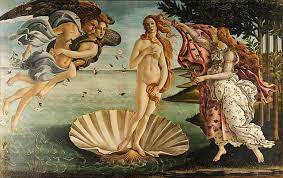
BIRTH OF VENUS
%%**(FIFTEENTH-CENTURY ITALY)**%%
==**(FLORENTINE ART IN 2ND HALF OF 15TH CENTURY)**==
%%**(FIFTEENTH-CENTURY ITALY)**%%
==**(FLORENTINE ART IN 2ND HALF OF 15TH CENTURY)**==
* Sandro Botticelli
* c. 1484–1486.
* Tempera and gold on canvas,
* 5′87⁄8″ × 9′17⁄8″ (1.8 × 2.8 m).
* Galleria degli Uffizi, Florence.
* c. 1484–1486.
* Tempera and gold on canvas,
* 5′87⁄8″ × 9′17⁄8″ (1.8 × 2.8 m).
* Galleria degli Uffizi, Florence.
70
New cards
Urbino, Mantua, Rome, and Venice
%%**(FIFTEENTH-CENTURY ITALY)**%%
==**(RENAIISANCE STYLE SPREADING TO OTHER ITALIAN CITIES)**==
%%**(FIFTEENTH-CENTURY ITALY)**%%
==**(RENAIISANCE STYLE SPREADING TO OTHER ITALIAN CITIES)**==
__***How does the Renaissance style spread from Florence to other Italian cities?***__
In the second half of the fifteenth century, the ideas and ideals of artists like Brunelleschi, Donatello, and Masaccio began to spread from Florence to the rest of Italy, as artists who had trained or worked in Florence traveled to other cities to work. Northern Italy embraced the new Classical ideas swiftly, especially in the court cities of Urbino and Mantua. Venice and Rome also emerged as innovative art centers in the last quarter of the century.
In the second half of the fifteenth century, the ideas and ideals of artists like Brunelleschi, Donatello, and Masaccio began to spread from Florence to the rest of Italy, as artists who had trained or worked in Florence traveled to other cities to work. Northern Italy embraced the new Classical ideas swiftly, especially in the court cities of Urbino and Mantua. Venice and Rome also emerged as innovative art centers in the last quarter of the century.
71
New cards
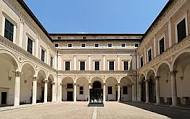
Urbino / THE PALACE AT URBINO / COURTYARD, DUCAL PALACE, URBINO
%%**(FIFTEENTH-CENTURY ITALY)**%%
==**(RENAIISANCE STYLE SPREADING TO OTHER ITALIAN CITIES)**==
%%**(FIFTEENTH-CENTURY ITALY)**%%
==**(RENAIISANCE STYLE SPREADING TO OTHER ITALIAN CITIES)**==
* Luciano Laurana
* Courtyard
* c. 1468–1472; palace begun c. 1450.
\
Urbino Under Federico da Montefeltro, Urbino developed into a thriving artistic center. A new palace was under construction, and prominent architects and artists were brought into the court to make the new princely residence a showcase of ducal splendor.
\
Construction of the palace had been underway for about 20 years in 1468 when Federico hired Luciano Laurana (c. 1420/1425–1479) to direct the work. Among Laurana’s major contributions to the palace were closing the courtyard with a fourth wing and redesigning the courtyard façades (FIG. 20–36). The result is a superbly rational solution to the problems created in courtyard design by the awkward juncture of the arcades at the four corners. The ground-level portico on each side has arches supported by columns, but piers embellished with pilasters bridge the corner angles. This arrangement avoided the awkward visual effect of two arches springing from a single column (SEE FIG. 20–10) and gave the corner a greater sense of stability. A variation of the composite capital (a Corinthian capital with added Ionic volutes) was used, perhaps for the first time, on the ground level. Corinthian pilasters flank the windows in the story above, forming divisions that repeat the bays of the portico. (The two low upper stories were added later.) The plain architrave was engraved with inscriptions praising Federico, added when the count became duke of Urbino in 1476. The interior of the Urbino palace likewise reflected its patron’s embrace of new Renaissance ideas and interest in Classical antiquity, seen in carved marble fireplaces and window and door surrounds. In creating luxurious home furnishings and interior decorations for sophisticated clients such as Federico, Italian artists found freedom to experiment with new subjects, treatments, and techniques. Among these was the creation of remarkable trompe l’oeil effects using exacting linear perspective and foreshortening in intarsia (wood inlay) decoration. An extraordinary example is on the walls of Federico da Montefeltro’s STUDIOLO, or study, a room for private conversation and the owner’s collection of fine books and art objects ( FIG. 20–37). The work, probably done by the architect and woodworker Giuliano da Maiano (1432–1490), carries the date 1476. The elaborate scenes in the small room are created entirely of wood inlaid on flat surfaces. Each detail is rendered with convincing illusionism: pilasters, carved cupboards with latticed doors, niches with statues, paintings, and built-in tables. Prominent in the decorative scheme is the prudent and industrious squirrel, a Renaissance symbol of the ideal ruler—in other words, of Federico da Montefeltro. A large “window” looks out onto an elegant marble loggia with a distant view of the countryside through its arches, and the shelves, cupboards, and tables are filled with all manner of fascinating things: scientific instruments, books, even the duke’s armor hanging like a suit in a closet.
* Courtyard
* c. 1468–1472; palace begun c. 1450.
\
Urbino Under Federico da Montefeltro, Urbino developed into a thriving artistic center. A new palace was under construction, and prominent architects and artists were brought into the court to make the new princely residence a showcase of ducal splendor.
\
Construction of the palace had been underway for about 20 years in 1468 when Federico hired Luciano Laurana (c. 1420/1425–1479) to direct the work. Among Laurana’s major contributions to the palace were closing the courtyard with a fourth wing and redesigning the courtyard façades (FIG. 20–36). The result is a superbly rational solution to the problems created in courtyard design by the awkward juncture of the arcades at the four corners. The ground-level portico on each side has arches supported by columns, but piers embellished with pilasters bridge the corner angles. This arrangement avoided the awkward visual effect of two arches springing from a single column (SEE FIG. 20–10) and gave the corner a greater sense of stability. A variation of the composite capital (a Corinthian capital with added Ionic volutes) was used, perhaps for the first time, on the ground level. Corinthian pilasters flank the windows in the story above, forming divisions that repeat the bays of the portico. (The two low upper stories were added later.) The plain architrave was engraved with inscriptions praising Federico, added when the count became duke of Urbino in 1476. The interior of the Urbino palace likewise reflected its patron’s embrace of new Renaissance ideas and interest in Classical antiquity, seen in carved marble fireplaces and window and door surrounds. In creating luxurious home furnishings and interior decorations for sophisticated clients such as Federico, Italian artists found freedom to experiment with new subjects, treatments, and techniques. Among these was the creation of remarkable trompe l’oeil effects using exacting linear perspective and foreshortening in intarsia (wood inlay) decoration. An extraordinary example is on the walls of Federico da Montefeltro’s STUDIOLO, or study, a room for private conversation and the owner’s collection of fine books and art objects ( FIG. 20–37). The work, probably done by the architect and woodworker Giuliano da Maiano (1432–1490), carries the date 1476. The elaborate scenes in the small room are created entirely of wood inlaid on flat surfaces. Each detail is rendered with convincing illusionism: pilasters, carved cupboards with latticed doors, niches with statues, paintings, and built-in tables. Prominent in the decorative scheme is the prudent and industrious squirrel, a Renaissance symbol of the ideal ruler—in other words, of Federico da Montefeltro. A large “window” looks out onto an elegant marble loggia with a distant view of the countryside through its arches, and the shelves, cupboards, and tables are filled with all manner of fascinating things: scientific instruments, books, even the duke’s armor hanging like a suit in a closet.
72
New cards
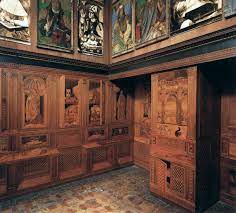
STUDIOLO OF FEDERICO DA MONTEFELTRO
%%**(FIFTEENTH-CENTURY ITALY)**%%
==**(RENAIISANCE STYLE SPREADING TO OTHER ITALIAN CITIES)**==
%%**(FIFTEENTH-CENTURY ITALY)**%%
==**(RENAIISANCE STYLE SPREADING TO OTHER ITALIAN CITIES)**==
* Giuliano da Maiano (?)
* Ducal palace, Urbino.
* 1476.
* Intarsia,
* height 7′3″ (2.21 m).
* Ducal palace, Urbino.
* 1476.
* Intarsia,
* height 7′3″ (2.21 m).
73
New cards
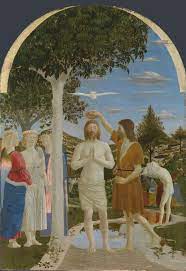
BAPTISM OF CHRIST
%%**(FIFTEENTH-CENTURY ITALY)**%%
==**(RENAIISANCE STYLE SPREADING TO OTHER ITALIAN CITIES)**==
%%**(FIFTEENTH-CENTURY ITALY)**%%
==**(RENAIISANCE STYLE SPREADING TO OTHER ITALIAN CITIES)**==
* Piero della Francesca
* c. 1450.
* Tempera on wood panel,
* 66 × 453⁄4″ (1.67 × 1.16 m).
* National Gallery, London.
\
* The three angels standing in a cluster at left, partially overlapped by the foreground tree, have been interpreted as an emblem of concord—representing the rapprochement reached between the Roman and Byzantine Christian churches in 1439 at the Council of Florence. Another reference to this council has been seen in the exotic costumes of the figures in the far background. Since the accord reached at the council was very short-lived, this interpretation would move the date of the painting into the early 1440s rather than the 1450s.
\
PIERO DELLA FRANCESCA Federico also brought the artist Piero della Francesca (c. 1415– 1492) to Urbino. Piero had worked in Florence in the 1430s before settling in his native Borgo San Sepolcro, a Tuscan hill town under papal control. He knew current art theory and art practice—including Brunelleschi’s system of spatial illusion and linear perspective, Masaccio’s powerful modeling of forms and atmospheric perspective, and Alberti’s theoretical treatises. Piero was one of the few practicing artists who also wrote his own books of theory. Not surprisingly, in his treatise on perspective he emphasized the geometry and the volumetric construction of forms and spaces that were so apparent in his own work. These characteristic features are clearly apparent in a serene image of the BAPTISM OF CHRIST that has become one of Piero’s signature works (FIG. 20–38). It was commissioned by the Graziani family, probably during the 1450s, for the priory of San Giovanni Battista in Borgo San Sepolchro. The central figure of Christ dominates the painting, standing in a shallow stream of glassy water under a tree of manicured regularity. Christ’s legs and the sleek tree trunk set up a series of emphatically upright forms, one of many formal relationships that reverberate both across the picture’s surface and into its carefully measured space. Feet and ankles rotate across the lower quarter of the painting, providing a clear and welldistributed sense of grounding for the figural composition, while the radically foreshortened dove (Holy Spirit), John’s baptismal dish, and the clouds create a rhythmic line of horizontals that adds stability above and creates a staccato rhythm that merges foreground and background on the painting’s surface. The mirrored profiles and gestures of the outside angel and the baptizing John provide an internal frame for the central action. Such carefully crafted formal correspondences infuse this picture with an air of quiet calm and peaceful stasis—a stillness suggesting that nothing will ever change, no one will ever move in this frozen moment within a story that, for Christian believers, actually changed everything.
* c. 1450.
* Tempera on wood panel,
* 66 × 453⁄4″ (1.67 × 1.16 m).
* National Gallery, London.
\
* The three angels standing in a cluster at left, partially overlapped by the foreground tree, have been interpreted as an emblem of concord—representing the rapprochement reached between the Roman and Byzantine Christian churches in 1439 at the Council of Florence. Another reference to this council has been seen in the exotic costumes of the figures in the far background. Since the accord reached at the council was very short-lived, this interpretation would move the date of the painting into the early 1440s rather than the 1450s.
\
PIERO DELLA FRANCESCA Federico also brought the artist Piero della Francesca (c. 1415– 1492) to Urbino. Piero had worked in Florence in the 1430s before settling in his native Borgo San Sepolcro, a Tuscan hill town under papal control. He knew current art theory and art practice—including Brunelleschi’s system of spatial illusion and linear perspective, Masaccio’s powerful modeling of forms and atmospheric perspective, and Alberti’s theoretical treatises. Piero was one of the few practicing artists who also wrote his own books of theory. Not surprisingly, in his treatise on perspective he emphasized the geometry and the volumetric construction of forms and spaces that were so apparent in his own work. These characteristic features are clearly apparent in a serene image of the BAPTISM OF CHRIST that has become one of Piero’s signature works (FIG. 20–38). It was commissioned by the Graziani family, probably during the 1450s, for the priory of San Giovanni Battista in Borgo San Sepolchro. The central figure of Christ dominates the painting, standing in a shallow stream of glassy water under a tree of manicured regularity. Christ’s legs and the sleek tree trunk set up a series of emphatically upright forms, one of many formal relationships that reverberate both across the picture’s surface and into its carefully measured space. Feet and ankles rotate across the lower quarter of the painting, providing a clear and welldistributed sense of grounding for the figural composition, while the radically foreshortened dove (Holy Spirit), John’s baptismal dish, and the clouds create a rhythmic line of horizontals that adds stability above and creates a staccato rhythm that merges foreground and background on the painting’s surface. The mirrored profiles and gestures of the outside angel and the baptizing John provide an internal frame for the central action. Such carefully crafted formal correspondences infuse this picture with an air of quiet calm and peaceful stasis—a stillness suggesting that nothing will ever change, no one will ever move in this frozen moment within a story that, for Christian believers, actually changed everything.
74
New cards
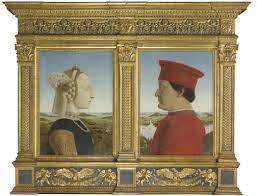
BATTISTA SFORZA AND FEDERICO DA MONTEFELTRO
%%**(FIFTEENTH-CENTURY ITALY)**%%
==**(RENAIISANCE STYLE SPREADING TO OTHER ITALIAN CITIES)**==
%%**(FIFTEENTH-CENTURY ITALY)**%%
==**(RENAIISANCE STYLE SPREADING TO OTHER ITALIAN CITIES)**==
* Piero della Francesca
* c. 1474.
* Oil on wood panel,
* each 181⁄2 × 13″ (47 × 33 cm).
* Galleria degli Uffizi, Florence.
\
* Battista Sforza died in 1472 at age 26, shortly after the birth of her ninth child, a son who would one day be duke. We are told that Federico was disconsolate. Some arranged aristocratic marriage alliances blossomed into loving partnerships, and it seems that one of them was memorialized in this double portrait.
\
Piero traveled widely—to Rome, to the Este court in Ferrara, and especially to Urbino. In about 1474, he painted the portraits of FEDERICO DA MONTEFELTRO and his recently deceased wife, BATTISTA SFORZA (FIG. 20–39). The small panels resemble Flemish painting in their detail and luminosity, their record of surfaces and textures, and their vast landscapes. But in traditional Italian fashion, figures are portrayed in strict profile, disengaged psychologically from the viewer. The profile format also allowed for an accurate recording of Federico’s likeness without emphasizing two disfiguring scars—the loss of his right eye from a lance blow and his broken nose. His good left eye is shown, and the angular profile of his nose might easily be merely a distinctive family trait. Typically, Piero emphasized the underlying geometry of the forms. Dressed in the most elegant fashion (Federico wears his red ducal robe and Battista’s jewels are meticulously recorded), they are silhouetted against a panoramic landscape. These are the hills around Urbino, seemingly dissolving into infinity through an atmospheric perspective as subtle and luminous as in any Flemish panel painting. Piero used another Northern European device: In the harbor view just in front of Federico, the water narrows into a river that leads us into the distant landscape (SEE FIG. 19–16). He would have had contact in Urbino with the Flemish artists who were also working there.
* c. 1474.
* Oil on wood panel,
* each 181⁄2 × 13″ (47 × 33 cm).
* Galleria degli Uffizi, Florence.
\
* Battista Sforza died in 1472 at age 26, shortly after the birth of her ninth child, a son who would one day be duke. We are told that Federico was disconsolate. Some arranged aristocratic marriage alliances blossomed into loving partnerships, and it seems that one of them was memorialized in this double portrait.
\
Piero traveled widely—to Rome, to the Este court in Ferrara, and especially to Urbino. In about 1474, he painted the portraits of FEDERICO DA MONTEFELTRO and his recently deceased wife, BATTISTA SFORZA (FIG. 20–39). The small panels resemble Flemish painting in their detail and luminosity, their record of surfaces and textures, and their vast landscapes. But in traditional Italian fashion, figures are portrayed in strict profile, disengaged psychologically from the viewer. The profile format also allowed for an accurate recording of Federico’s likeness without emphasizing two disfiguring scars—the loss of his right eye from a lance blow and his broken nose. His good left eye is shown, and the angular profile of his nose might easily be merely a distinctive family trait. Typically, Piero emphasized the underlying geometry of the forms. Dressed in the most elegant fashion (Federico wears his red ducal robe and Battista’s jewels are meticulously recorded), they are silhouetted against a panoramic landscape. These are the hills around Urbino, seemingly dissolving into infinity through an atmospheric perspective as subtle and luminous as in any Flemish panel painting. Piero used another Northern European device: In the harbor view just in front of Federico, the water narrows into a river that leads us into the distant landscape (SEE FIG. 19–16). He would have had contact in Urbino with the Flemish artists who were also working there.
75
New cards

TWO VIEWS OF THE CAMERA PICTA, DUCAL PALACE, MANTUA
%%**(FIFTEENTH-CENTURY ITALY)**%%
==**(RENAIISANCE STYLE SPREADING TO OTHER ITALIAN CITIES)**==
%%**(FIFTEENTH-CENTURY ITALY)**%%
==**(RENAIISANCE STYLE SPREADING TO OTHER ITALIAN CITIES)**==
* Andrea Mantegna
* 1465–1474.
* Fresco,
* diameter of false oculus 8′9″ (2.7 m); room 26′6″ (8 m) square
* 1465–1474.
* Fresco,
* diameter of false oculus 8′9″ (2.7 m); room 26′6″ (8 m) square
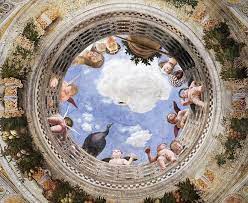
76
New cards
Mantua
%%**(FIFTEENTH-CENTURY ITALY)**%%
==**(RENAIISANCE STYLE SPREADING TO OTHER ITALIAN CITIES)**==
%%**(FIFTEENTH-CENTURY ITALY)**%%
==**(RENAIISANCE STYLE SPREADING TO OTHER ITALIAN CITIES)**==
Ludovico Gonzaga, the marquis of Mantua, ruled a territory that lies on the north Italian plain between Venice and Milan. Like Federico, he made his fortune as a condottiere. Ludovico was schooled by humanist teachers and created a court where humanist ideas flourished in art as well as in literature.
77
New cards
MANTEGNA
%%**(FIFTEENTH-CENTURY ITALY)**%%
==**(RENAIISANCE STYLE SPREADING TO OTHER ITALIAN CITIES)**==
%%**(FIFTEENTH-CENTURY ITALY)**%%
==**(RENAIISANCE STYLE SPREADING TO OTHER ITALIAN CITIES)**==
Working at Ludovico’s court was Andrea Mantegna (1431–1506), a painter trained in Padua and profoundly influenced by the sculptor Donatello, who arrived in Padua in 1443 and worked there for a decade. Mantegna learned the Florentine system of linear perspective and pushed it to its limits with radically foreshortened forms and dramatic spatial recessions. He went to work for Ludovico Gonzaga in 1460 and continued to work for the Gonzaga family for the rest of his life. Perhaps his finest works are the frescos of the CAMERA PICTA (“Painted Room”), a tower chamber in Ludovico’s palace, which Mantegna decorated between 1465 and 1474 (FIG. 20–40). Around the walls the family—each member seemingly identified by a portrait likeness—learns of the return of and ultimately welcomes Ludovico’s son, Cardinal Francesco Gonzaga. On the domed ceiling, the artist painted a tour-de-force of radical perspective in a technique called di sotto in sù (“from below upwards”). The room appears to be open to a cloud-filled sky through a large oculus in a simulated marble- and mosaic-covered vault. On each side of a precariously balanced planter, four young women— one an African, outfitted in an exotic turban—peer over a marble balustrade into the room below, while a fourth looks dreamily upward. Joined by a large peacock, several putti play around the balustrade, seemingly oblivious to the danger of their perch. Three stand on the interior ledge of a cornice unprotected by the balustrade, toes projecting into space. This ceiling began a long tradition of illusionistic ceiling painting that culminated in the extravagant and explosive ceilings of Baroque churches (see Chapter 23) his contributions, Christ Giving the Keys to St. Peter (foreground painting at lower right in FIG. 20–41; also FIG. 20–20A), portrayed the event that provided biblical support for the supremacy of papal authority (Matthew 16:19). In a light-filled piazza in which banded paving stones provide a geometric grid for perspectival recession, the figures stand like chess pieces on the squares, scaled to size according to their distance from the picture plane and modeled by a consistent light source from the upper left. Triumphal arches inspired by ancient Rome frame the church and focus attention on the center of the composition, where the vital key is being transferred. The carefully calibrated scene is softened by the subdued colors, the distant idealized landscape and cloudy skies, and the variety of the figures’ positions.
78
New cards
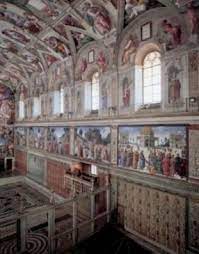
VIEW OF THE SISTINE CHAPEL SHOWING PAINTINGS COMMISSIONED FOR THE SIDE WALLS BY POPE SIXTUS IV
%%**(FIFTEENTH-CENTURY ITALY)**%%
==**(RENAIISANCE STYLE SPREADING TO OTHER ITALIAN CITIES)**==
%%**(FIFTEENTH-CENTURY ITALY)**%%
==**(RENAIISANCE STYLE SPREADING TO OTHER ITALIAN CITIES)**==
* Vatican, Rome.
* At lower right, Perugino’s Christ Giving the Keys to St. Peter,
* c. 1480–1482.
* 11′51⁄2″ × 18′81⁄2″ (3.48 × 5.7 m)
* At lower right, Perugino’s Christ Giving the Keys to St. Peter,
* c. 1480–1482.
* 11′51⁄2″ × 18′81⁄2″ (3.48 × 5.7 m)
79
New cards
Rome
%%**(FIFTEENTH-CENTURY ITALY)**%%
==**(RENAIISANCE STYLE SPREADING TO OTHER ITALIAN CITIES)**==
%%**(FIFTEENTH-CENTURY ITALY)**%%
==**(RENAIISANCE STYLE SPREADING TO OTHER ITALIAN CITIES)**==
Rome’s development into a Renaissance center of the arts was greatly enhanced in the early 1480s when Pope Sixtus IV called to the city a group of young Florentine and Umbrian artists to decorate the walls of his newly built chapel (1479–1481), now named the SISTINE CHAPEL after him (FIG. 20–41). Botticelli and Ghirlandaio were among the most famous artists summoned to the chapel to paint, but many art historians believe that Perugino was the supervising artist in charge of the project.
80
New cards
PERUGINO
%%**(FIFTEENTH-CENTURY ITALY)**%%
==**(RENAIISANCE STYLE SPREADING TO OTHER ITALIAN CITIES)**==
%%**(FIFTEENTH-CENTURY ITALY)**%%
==**(RENAIISANCE STYLE SPREADING TO OTHER ITALIAN CITIES)**==
Pietro Vannucci, called “Perugino” (c. 1445–1523), was originally from near the town of Perugia in Umbria (thus the nickname), and he worked for a while in Florence, but by 1479 he was in Rome. Two years later, he was working on the Sistine murals. One of his contributions, Christ Giving the Keys to St. Peter (foreground painting at lower right in FIG. 20–41; also FIG. 20–20A), portrayed the event that provided biblical support for the supremacy of papal authority (Matthew 16:19). In a light-filled piazza in which banded paving stones provide a geometric grid for perspectival recession, the figures stand like chess pieces on the squares, scaled to size according to their distance from the picture plane and modeled by a consistent light source from the upper left. Triumphal arches inspired by ancient Rome frame the church and focus attention on the center of the composition, where the vital key is being transferred. The carefully calibrated scene is softened by the subdued colors, the distant idealized landscape and cloudy skies, and the variety of the figures’ positions.
81
New cards
Venice
%%**(FIFTEENTH-CENTURY ITALY)**%%
==**(RENAIISANCE STYLE SPREADING TO OTHER ITALIAN CITIES)**==
%%**(FIFTEENTH-CENTURY ITALY)**%%
==**(RENAIISANCE STYLE SPREADING TO OTHER ITALIAN CITIES)**==
In the last quarter of the fifteenth century, Venice emerged as a major Renaissance art center. Ruled as an oligarchy (government by a select few) with an elected duke (doge in the Venetian dialect), the city government was founded at the end of the Roman Empire and survived until the Napoleonic era. In building their city, the Venetians had turned marshes into a commercial seaport, and they saw the sea as a resource, not a threat. They depended on naval power and on the natural defense of their lagoons rather than city walls. Venice turned toward the east, especially after the crusaders’ conquest of Constantinople in 1204, designing the church of St. Mark as a great Byzantine building sheathed in mosaics (SEE FIG. 8–24A). In addition to its long history of painting and sculpture, Venice excelled in the arts of textiles and jewelry, gold and enamel, glass and mosaic, fine printing and bookbinding.
82
New cards
VENETIAN PALACES
%%**(FIFTEENTH-CENTURY ITALY)**%%
==**(RENAIISANCE STYLE SPREADING TO OTHER ITALIAN CITIES)**==
%%**(FIFTEENTH-CENTURY ITALY)**%%
==**(RENAIISANCE STYLE SPREADING TO OTHER ITALIAN CITIES)**==
Venice was a city of waterways with few large public spaces. Even palaces had only small interior courtyards and tiny gardens and were separated by narrow alleys. Their façades overlooked the canals, permitting owners to display on these major thoroughfares the large portals, windows, and loggias that proclaimed their importance through the lavishness of their residences—a sharp contrast to the fortresslike character of most Florentine town houses (SEE FIG. 20–9). Similar to the Florentine great houses, however, Venetian structures combined a place of business with a dwelling.
83
New cards
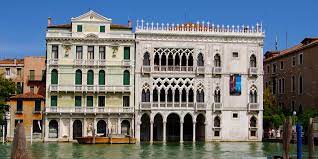
CA D’ORO (CONTARINI PALACE), VENICE
%%**(FIFTEENTH-CENTURY ITALY)**%%
==**(RENAIISANCE STYLE SPREADING TO OTHER ITALIAN CITIES)**==
%%**(FIFTEENTH-CENTURY ITALY)**%%
==**(RENAIISANCE STYLE SPREADING TO OTHER ITALIAN CITIES)**==
* 1421–1437.
\
The CA D’ORO (House of Gold), home of the wealthy nobleman Marino Contarini, has a splendid front with three superimposed loggias facing the Grand Canal (FIG. 20–42). The house was constructed between 1421 and 1437, and its asymmetrical elevation is based on a traditional Byzantine plan. A wide central hall ran from front to back all the way through the building to a small inner courtyard with a well and garden. The entrance on the canal permitted goods to be delivered directly into the warehouse that constituted the ground floor. An outside stair led to the main floor on the second level, which had a salon and reception room opening on the richly decorated loggia. It was filled with light from large windows, and more light reflected off the polished terrazzo floor. Private family rooms filled the upper stories. Contarini specified that the façade was to be painted with white enamel and ultramarine blue and that the red stones in the patterned wall should be oiled to make them even brighter. Details of carving, such as coats of arms and balls on the crest at the roofline, were to be gilded. Beautiful as the palace is today, in the fifteenth and sixteenth centuries it must have been truly spectacular.
\
The CA D’ORO (House of Gold), home of the wealthy nobleman Marino Contarini, has a splendid front with three superimposed loggias facing the Grand Canal (FIG. 20–42). The house was constructed between 1421 and 1437, and its asymmetrical elevation is based on a traditional Byzantine plan. A wide central hall ran from front to back all the way through the building to a small inner courtyard with a well and garden. The entrance on the canal permitted goods to be delivered directly into the warehouse that constituted the ground floor. An outside stair led to the main floor on the second level, which had a salon and reception room opening on the richly decorated loggia. It was filled with light from large windows, and more light reflected off the polished terrazzo floor. Private family rooms filled the upper stories. Contarini specified that the façade was to be painted with white enamel and ultramarine blue and that the red stones in the patterned wall should be oiled to make them even brighter. Details of carving, such as coats of arms and balls on the crest at the roofline, were to be gilded. Beautiful as the palace is today, in the fifteenth and sixteenth centuries it must have been truly spectacular.
84
New cards
THE BELLINI BROTHERS
%%**(FIFTEENTH-CENTURY ITALY)**%%
==**(RENAIISANCE STYLE SPREADING TO OTHER ITALIAN CITIES)**==
%%**(FIFTEENTH-CENTURY ITALY)**%%
==**(RENAIISANCE STYLE SPREADING TO OTHER ITALIAN CITIES)**==
The domes of the church of St. Mark dominated the city center, and the rich colors of its glowing mosaics captured painters’ imaginations. Perhaps it was their love of color that encouraged the Venetian painters to embrace the oil medium for both panel and canvas painting. The most important Venetian artists of this period were two brothers: Gentile (c. 1429–1507) and Giovanni (c. 1430–1516) Bellini, whose father, Jacopo (c. 1400–1470), had also been a central figure in Venetian art. Andrea Mantegna became part of this circle when he married Jacopo’s daughter in 1453. Gentile Bellini celebrated the daily life of the city in large, lively narratives, such as the PROCESSION OF THE RELIC OF THE TRUE CROSS BEFORE THE CHURCH OF ST. MARK (FIG. 20–43). Every year on the feast of St. Mark (April 25), the Confraternity of St. John the Evangelist carried the miracle-working relic of the True Cross in a procession through the square in front of the church. Bellini’s painting of 1496 depicts an event that had occurred in 1444: the miraculous recovery of a sick child whose father (the man in red kneeling to the right of the relic) prayed for help as the relic passed by. Gentile has rendered the cityscape with great attention to detail. The mosaic-encrusted Byzantine Cathedral of St. Mark (SEE FIG. 8–24A) forms a backdrop for the procession, and the doge’s palace and base of the bell tower can be seen at the right. The gold reliquary is carried under a canopy, surrounded by marchers with giant candles led by a choir and followed at the far right by the doge and other officials. Gentile’s procession serves as a reminder that fifteenth-century piazzas and buildings were sites of ceremony, and it was in moments such as this that they were brought to life. G e n t i l e ’ s b r o t h e r G i o v a n n i a m a z e d a n d attracted patrons with his artistic virtuosity for almost 60 years. The VIRGIN AND CHILD ENTHRONED WITH SS. FRANCIS, JOHN THE BAPTIST, JOB, DOMINIC, SEBASTIAN, AND LOUIS OF TOULOUSE (FIG. 20–44), painted in about 1478 for the chapel of the Hospital of San Giobbe (St. Job), exhibits a dramatic perspectival view up into a tunnel vault that leads to an apse. Giovanni may have known his brother-in-law Mantegna’s early experi - ments in radical foreshortening and the use of a low vanishing point. Here Giovanni positions the vanishing point for the rapidly converging lines of the architecture at bottom center, just above the floor. His figures stand in a Classical architectural interior with a coffered bar - rel vault reminiscent of Masaccio’s Trinity (SEE FIG. 20–18). The gold mosaic, with its identifying inscription and styl - ized seraphim (angels of the highest rank), recalls Byz - antine art and the long tradition of Byzantine-inspired painting and mosaics in Venice. Giovanni Bellini’s painting of ST. FRANCIS IN ECSTASY (FIG. 20–45), also from the 1470s, recalls Flem - ish painting in the fine detail with which the natural world is rendered. The saint stands bathed in early morning sunlight, his outspread hands displaying his stigmata. Francis had moved to a cave in the barren wilderness in his search for communion with God, but in the world Giovanni creates for him, the fields blos - som and flocks of animals graze. The grape arbor over his desk adds to the atmosphere of sylvan delight. Like most of the fifteenth-century religious art we have seen, however, Giovanni presents viewers with a natural world saturated in symbolism. Here a relationship between St. Francis and Moses is outlined. The tree symbolizes the burning bush; the stream, the miraculous spring brought forth by Moses. The crane and donkey represent the monastic virtue of patience. The detailed description, luminous palette, and symbolic surroundings suggest Flemish art, but the golden light suffusing the painting is unmistakably Venetian.
85
New cards
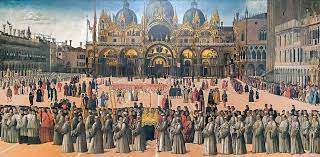
PROCESSION OF THE RELIC OF THE TRUE CROSS BEFORE THE CHURCH OF ST. MARK
%%**(FIFTEENTH-CENTURY ITALY)**%%
==**(RENAIISANCE STYLE SPREADING TO OTHER ITALIAN CITIES)**==
%%**(FIFTEENTH-CENTURY ITALY)**%%
==**(RENAIISANCE STYLE SPREADING TO OTHER ITALIAN CITIES)**==
* Gentile Bellini
* 1496.
* Oil on canvas,
* 12 ′ × 24 ′ 5 ″ (3.67 × 7.45 m).
* Galleria dell’Accademia, Venice.
* 1496.
* Oil on canvas,
* 12 ′ × 24 ′ 5 ″ (3.67 × 7.45 m).
* Galleria dell’Accademia, Venice.
86
New cards
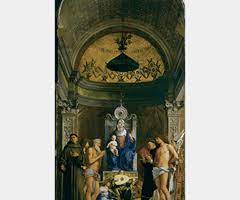
VIRGIN AND CHILD ENTHRONED WITH SS. FRANCIS, JOHN THE BAPTIST, JOB, DOMINIC, SEBASTIAN, AND LOUIS OF TOULOUSE
%%**(FIFTEENTH-CENTURY ITALY)**%%
==**(RENAIISANCE STYLE SPREADING TO OTHER ITALIAN CITIES)**==
%%**(FIFTEENTH-CENTURY ITALY)**%%
==**(RENAIISANCE STYLE SPREADING TO OTHER ITALIAN CITIES)**==
* Giovanni Bellini
* Originally commissioned for the chapel of the Hospital of San Giobbe, Venice.
* c. 1478.
* Oil on wood panel,
* 15 ′ 4 ″ × 8 ′ 4 ″ (4.67 × 2.54 m).
* Galleria dell’Accademia, Venice
\
* Art historians have given the name sacra conversazione (“holy conversation”) to this type of composition that shows saints, angels, and sometimes even the painting’s donors in the same pictorial space with the enthroned Virgin and Child. Despite the name, no “conversation” or spoken interaction takes place in a literal sense. Instead, the individuals portrayed are joined in a mystical and eternal communion that occurs outside human time and space
* Originally commissioned for the chapel of the Hospital of San Giobbe, Venice.
* c. 1478.
* Oil on wood panel,
* 15 ′ 4 ″ × 8 ′ 4 ″ (4.67 × 2.54 m).
* Galleria dell’Accademia, Venice
\
* Art historians have given the name sacra conversazione (“holy conversation”) to this type of composition that shows saints, angels, and sometimes even the painting’s donors in the same pictorial space with the enthroned Virgin and Child. Despite the name, no “conversation” or spoken interaction takes place in a literal sense. Instead, the individuals portrayed are joined in a mystical and eternal communion that occurs outside human time and space
87
New cards
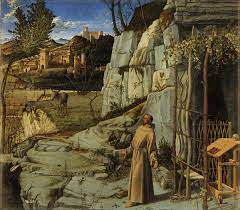
ST. FRANCIS IN ECSTASY
%%**(FIFTEENTH-CENTURY ITALY)**%%
==**(RENAIISANCE STYLE SPREADING TO OTHER ITALIAN CITIES)**==
%%**(FIFTEENTH-CENTURY ITALY)**%%
==**(RENAIISANCE STYLE SPREADING TO OTHER ITALIAN CITIES)**==
* Giovanni Bellini
* c. 1470s.
* Oil on wood panel,
* 491⁄16 × 557⁄8″ (124.6 × 142 cm).
* The Frick Collection, New York.
* c. 1470s.
* Oil on wood panel,
* 491⁄16 × 557⁄8″ (124.6 × 142 cm).
* The Frick Collection, New York.
88
New cards
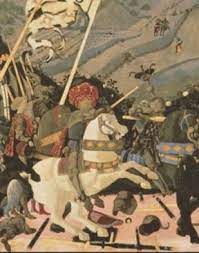
NICCOLÒ DA TOLENTINO LEADING THE CHARGE Detail
%%**(FIFTEENTH-CENTURY ITALY)**%%
==**(RENAIISANCE STYLE SPREADING TO OTHER ITALIAN CITIES)**==
%%**(FIFTEENTH-CENTURY ITALY)**%%
==**(RENAIISANCE STYLE SPREADING TO OTHER ITALIAN CITIES)**==
* Paolo Uccello
* detail from The Battle of San Romano (FIG. 20–24),
* 1438–1440.
* Tempera on wood panel. National Gallery, London.
* detail from The Battle of San Romano (FIG. 20–24),
* 1438–1440.
* Tempera on wood panel. National Gallery, London.